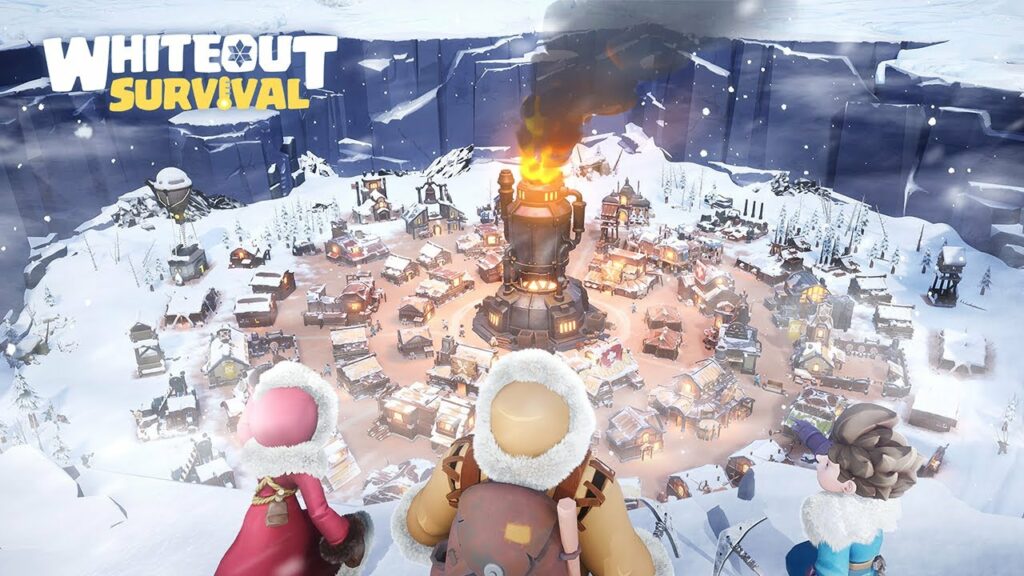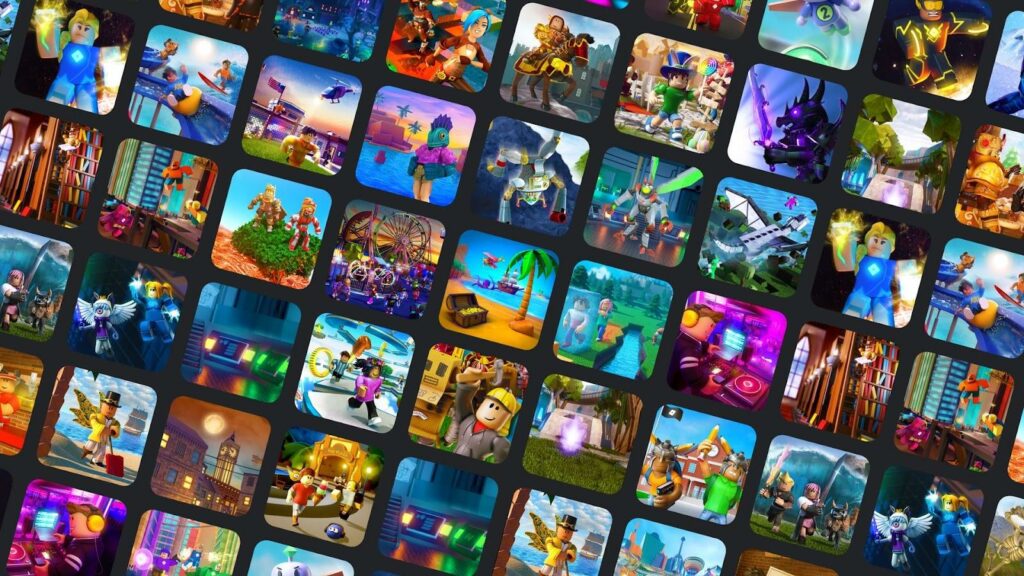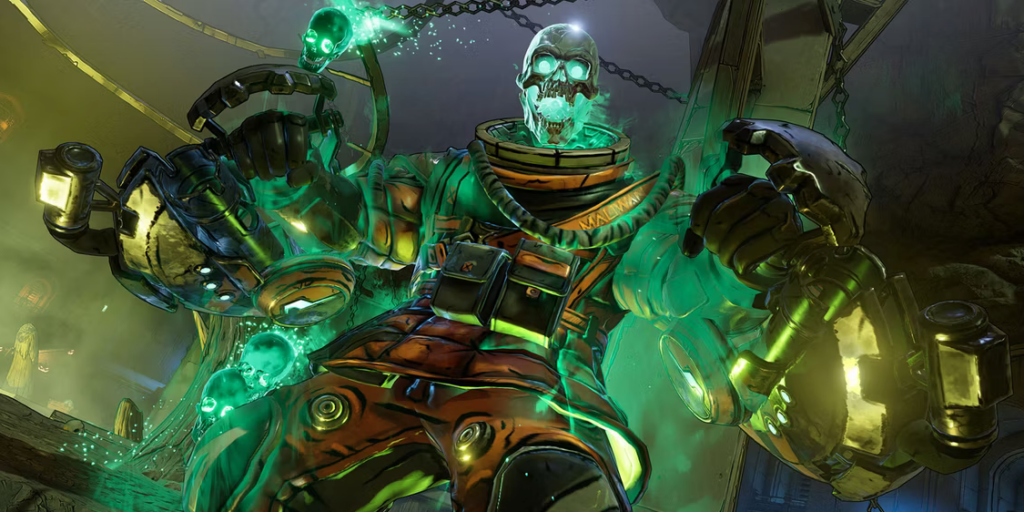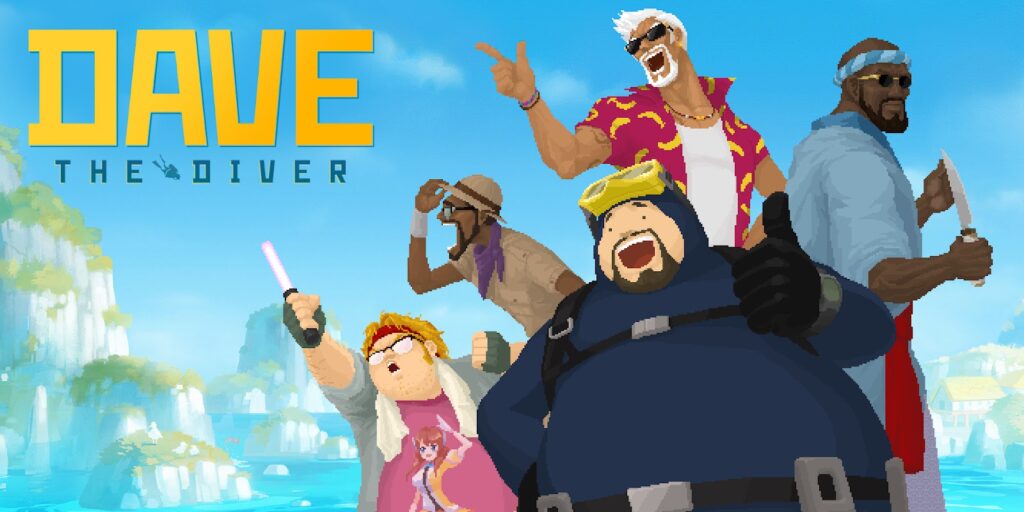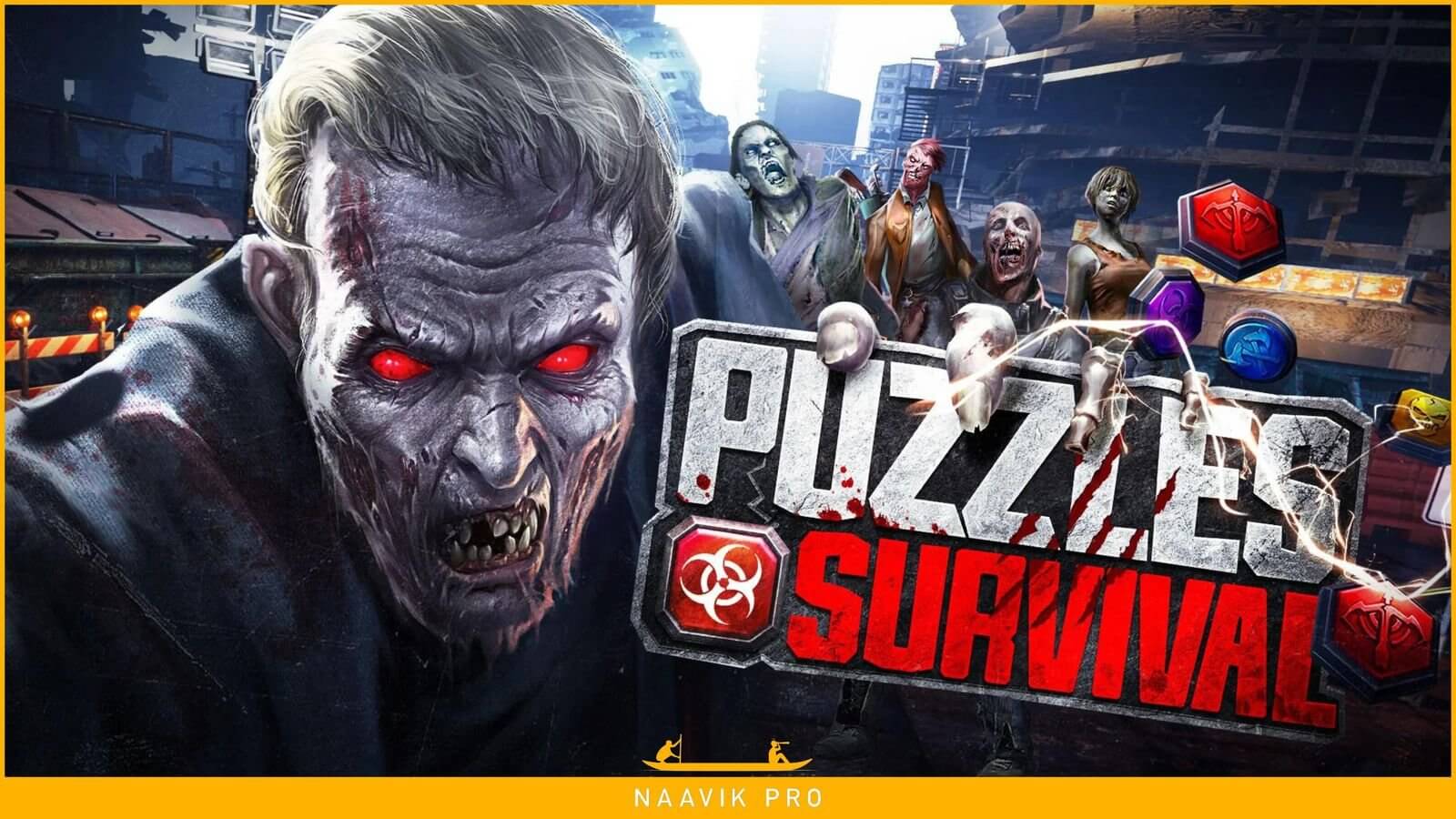
Executive Summary
- Puzzles & Survival (PNS) is a hybrid March-Battle 4X game with Match 3 RPG elements, developed and published by Chinese developer 37Games (a part of 37 Entertainment).
- PNS is a follow-up to Puzzles and Conquest, with the theme changed to a zombie apocalypse to make it more widely appealing to the strategy games’ audience.
- PNS has continued to be a top-grossing title in the US since May 2022, generating 595m from 32.7m downloads worldwide.
- With deep hero collector RPG mechanics and monetization combined with the pay-to-win 4X genre’s pay-for-power, PNS has successfully cracked a broader hybrid 4X market.
- The hybrid Match 3 gameplay is featured heavily in the game’s UA and helps the game navigate the world of less-targeted advertising in the post-IDFA environment.
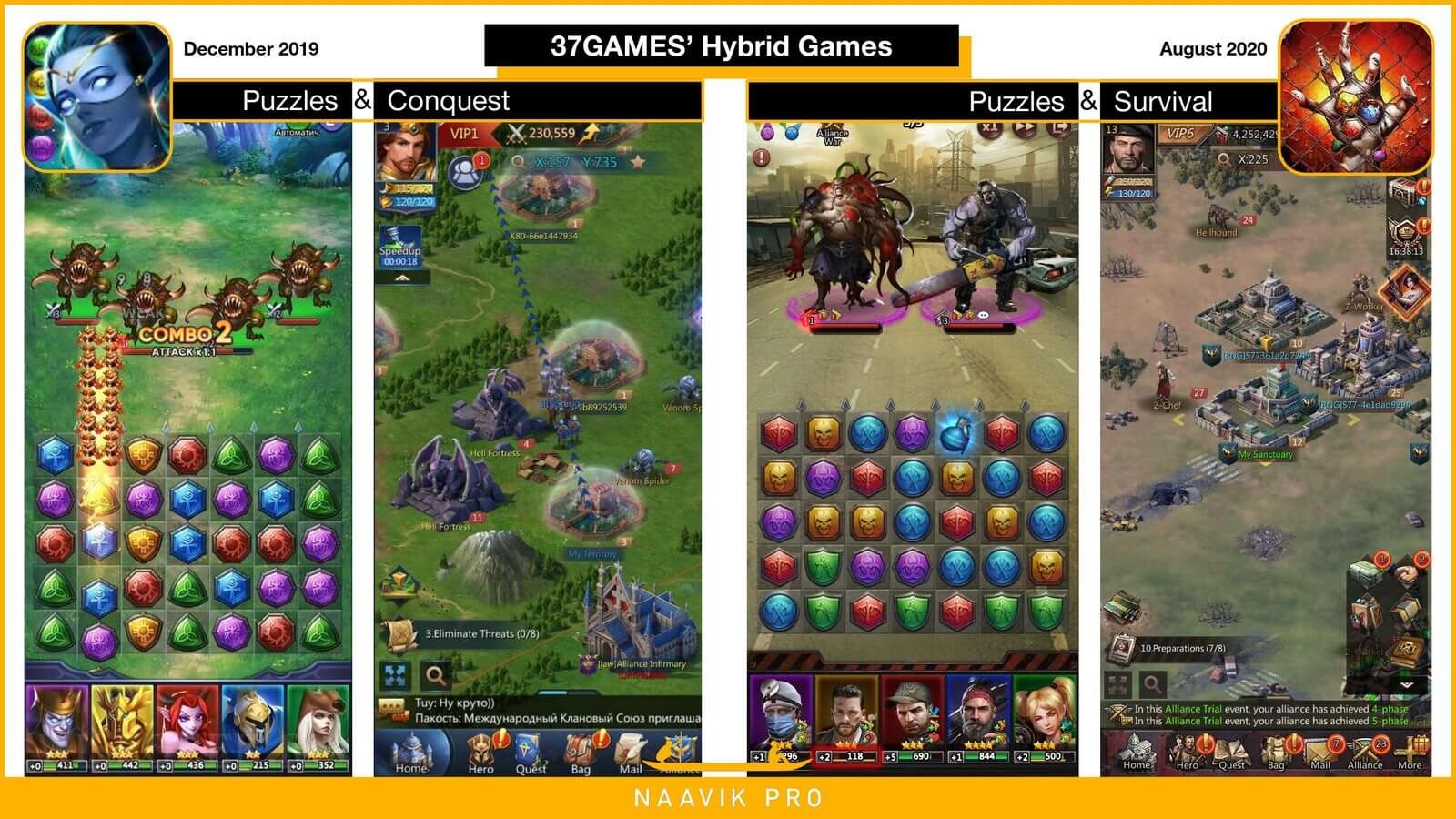
37GAMES’ Bet on Hybrid Games and Zombies
In December 2019, 37GAMES launched an innovative hybrid take on the 4X genre titled Puzzles & Conquest — a mix of match-3 RPG along the likes of Empires & Puzzles and a march-battle 4X game, set in a fantasy universe with mythological heroes. At Google’s Think Games event the team shared that the game was profitable but didn’t manage to scale due to rising UA costs (link). Other post-apocalyptic zombie games on the market, namely FunPlus’ 4X game State of Survival: Zombie War (SoS) which launched globally April 2019, helped 37Games verify the potential of the theme and its compatibility for strategic gameplay set in a zombies-infested world.
Thus was born Puzzles & Survival (PNS) — a follow-up to Puzzles & Conquest and a hybrid 4X Match 3 game set in the wake of a zombie apocalypse that launched in August 2020. 37Games continued to launch several other 4X-only games during the same period, like Wild Frontier (launched December 2019) set in the American Wild West and Ant Legion (launched August 2020) set in the miniaturized world of ants, though none of the games could come close to the performance of PNS. Their approach to hybrid game design that mixes gameplay from different genres smoothly together as well as testing thematic reskins to pick a theme closely fitting the strategy audience had massively paid off.
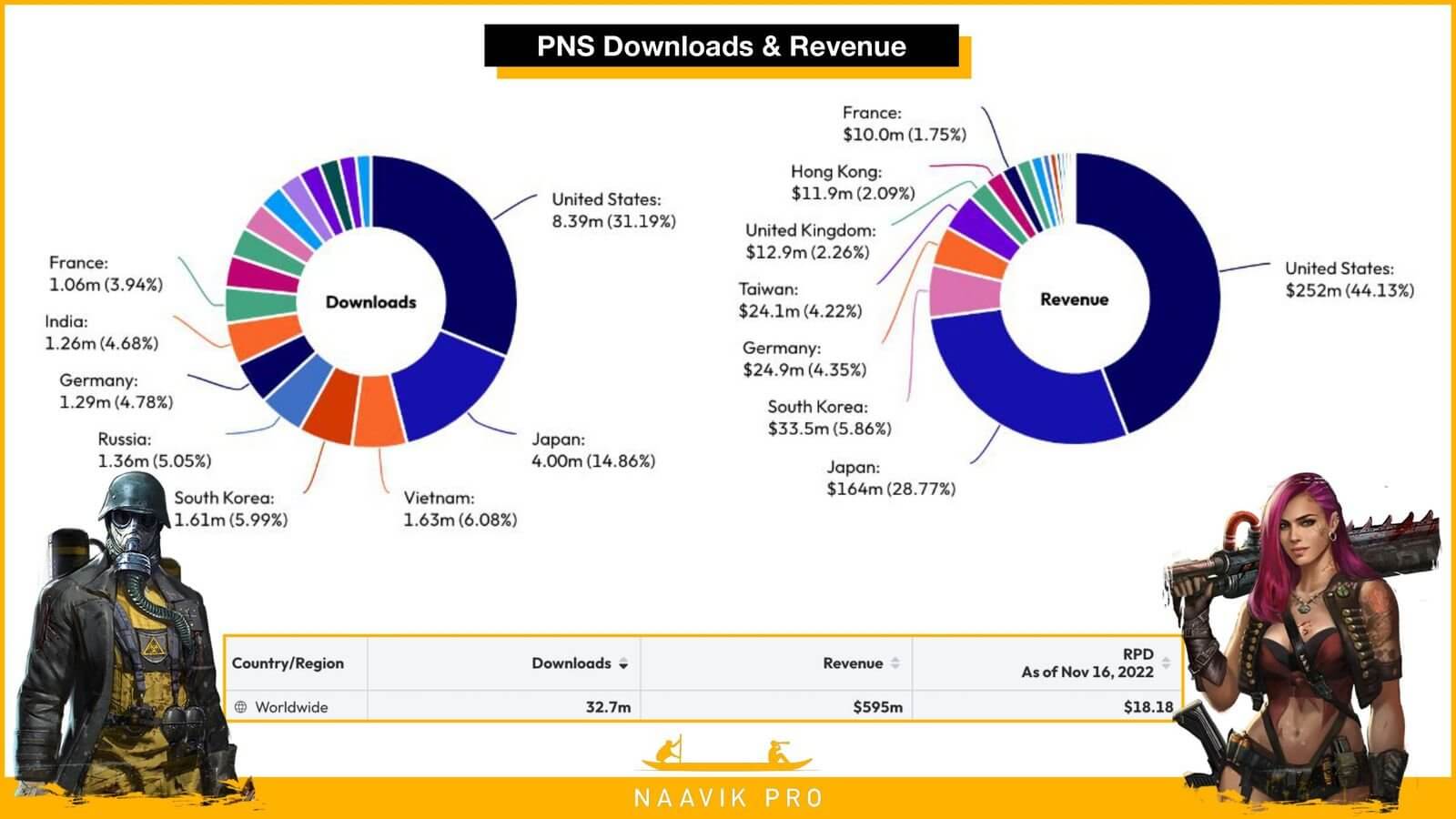
Since its release in August 2020 to November 2022 (27 months), PNS has generated $595m in revenue over 32.7m downloads worldwide across iOS and Android, with a Revenue Per Download (RPD) of $18.18. The US leads both charts with $252m (44%) of cumulative revenue and 8.39m (31%) of cumulative downloads. PNS’ second and third biggest markets by revenue are Japan and South Korea with $164m (29%) and 33.5m (6%) respectively. Japan also follows second in downloads with 4m (15%) of cumulative downloads. The game has generated over 1m downloads in several countries like Vietnam, South Korea, Russia, Germany, India, and France.
The US and Japan drive over 70% of PNS’ revenue, and the game’s revenue grew in Japan a few months after the US. Top-grossing games in Japan show an affinity for Hero Collector RPGs like Uma Musume Pretty Derby and Fate/Grand Order, Puzzle Match 3 RPGs like Puzzle & Dragons and Dragon Ball Z Dokkan Battle, as well as 4X games like Mafia City and Age of Origins Z. PNS’ success story in Japan comes from being at a crossroads of the genres the region loves best as a Puzzle Match 3 Hero Collector RPG 4X game.
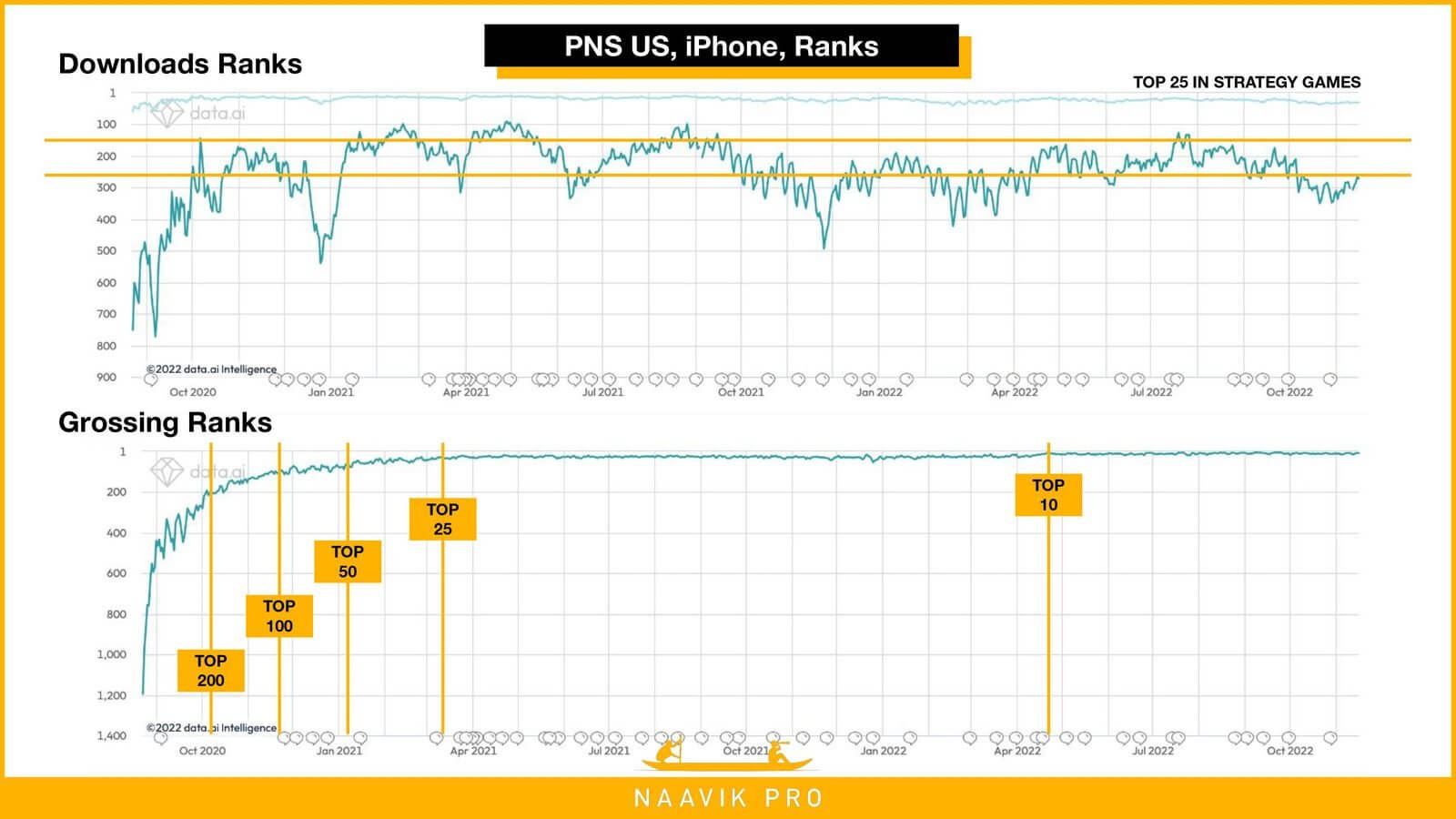
PNS has had stellar movement in the rankings: when looking at US iPhone top-grossing ranks for all games, PNS entered the top 100 less than three months after launch and continued to rise up the ranks to break into the highly coveted top 10 grossing spot and staying there since May 2022. As for the download ranks, the game has maintained a steady top 150-250 ranks in games overall and top 25 in strategy games.
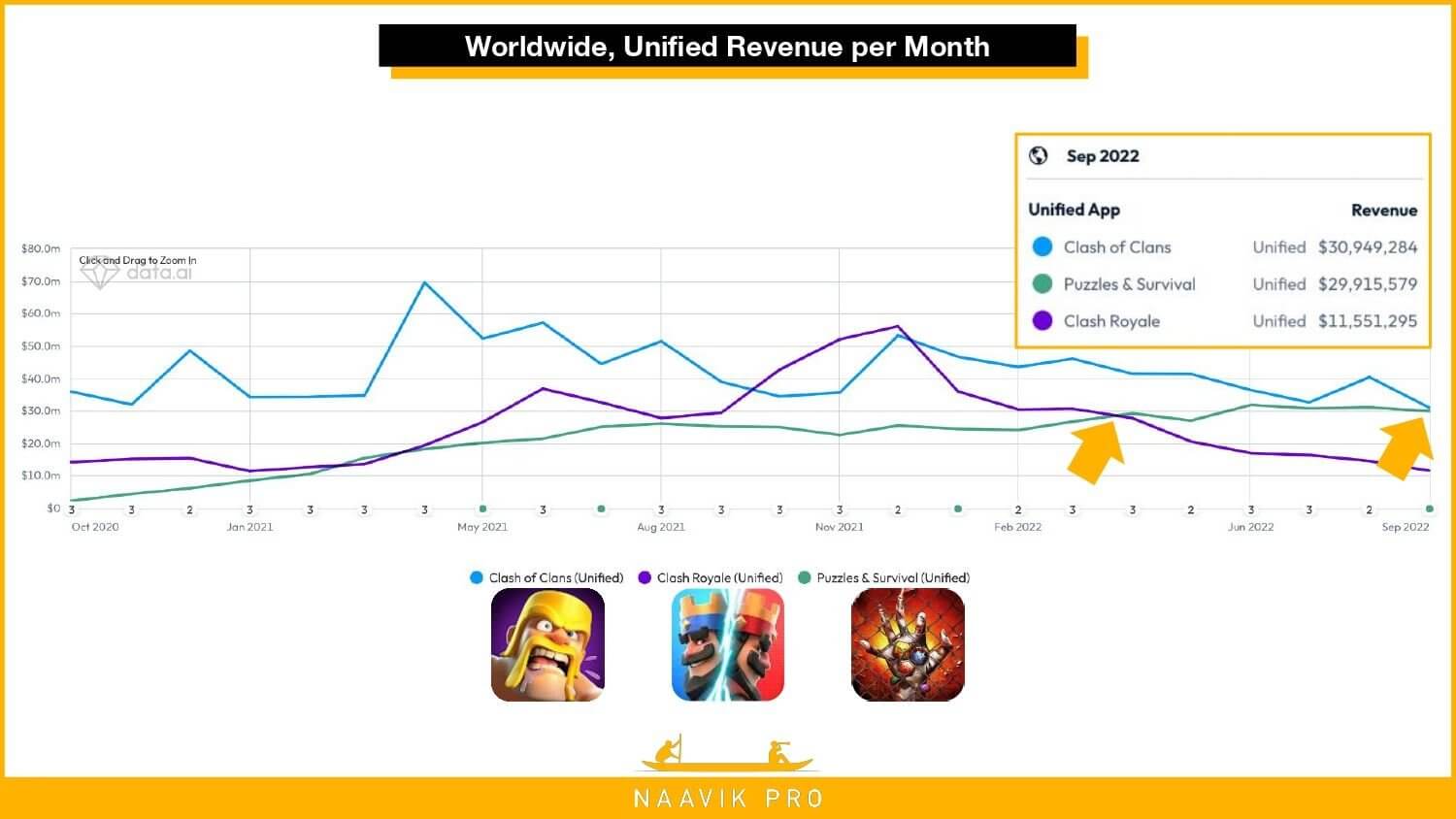
Another point of note is PNS’ monthly worldwide revenue surpassed Supercell’s Clash Royale by April 2022 and is trending very close to Clash of Clans by September 2022. This really goes to showcase how far the game has come since its initial launch period and how well it has been able to scale revenues over that time.
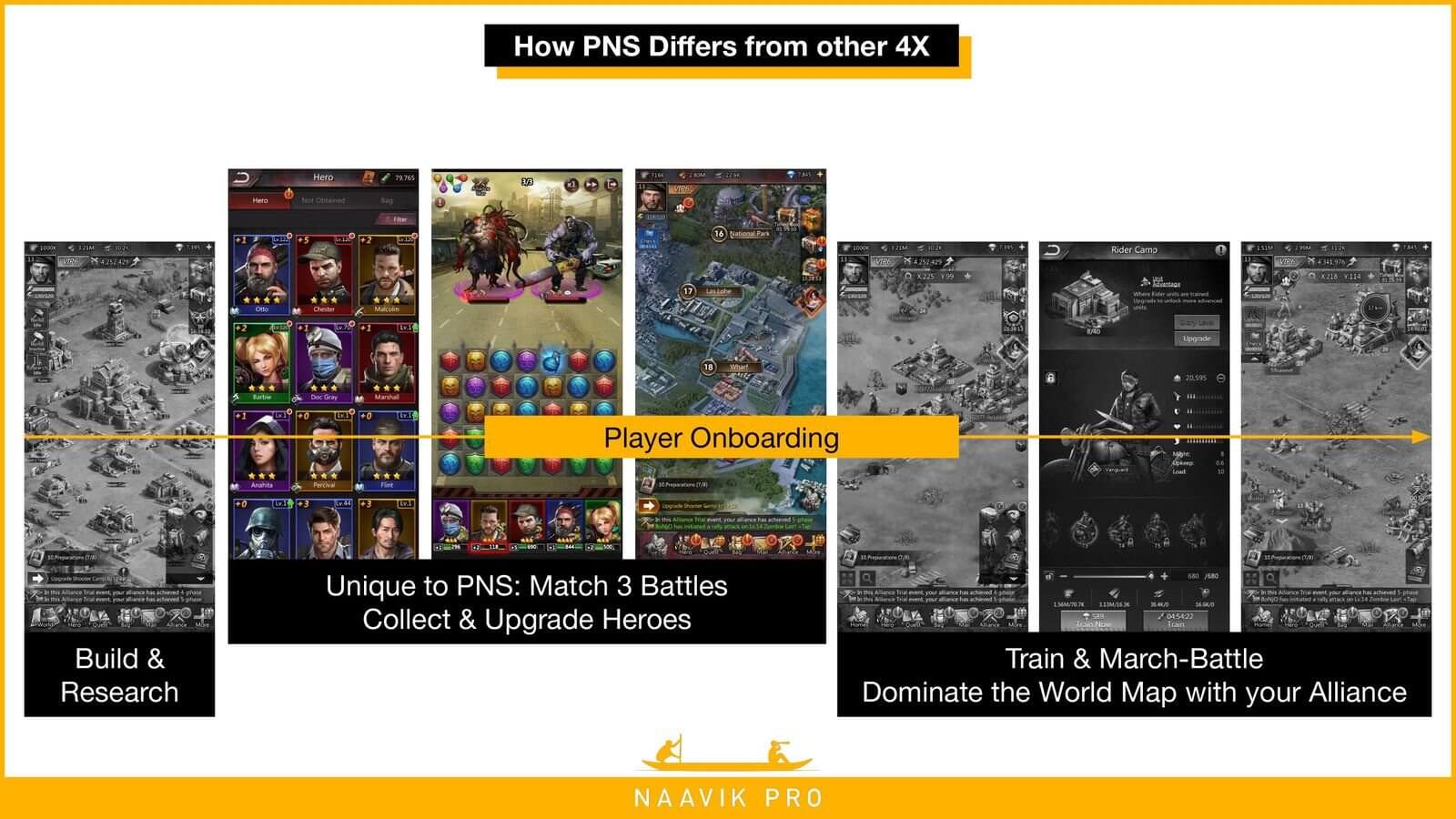
4X games are notorious for their high complexity in the early game, taking players through all the game’s mechanics of building, researching, training, and march-battling on a persistent shared world map with countless other players playing on the same server. Though this sounds exciting on paper, in practice, it boils down to taking players through tedious, never-ending tutorials, tapping away mindlessly through a boring (but sometimes necessary) onboarding that introduces all of the game’s complex, intertwining systems and mechanics.
These systems and mechanics truly come to shine in the mid-to-late game, bringing a lot of hidden depth and mastery to light as players band together in alliances and try to dominate the world map. PNS’ Match 3 battles and RPG progression of collecting and upgrading heroes is an attempt to solve the early game boredom stemming from the complex onboarding. The early game strategy of the Match 3 battles and progression vectors for growth of the heroes forms a helpful strategy foundation that the 4X part of the game expands and builds upon later without bombarding players with its complexity upfront.
At the heart of this smooth onboarding change is a ‘less is more’ approach taken by other successful modern games in the genre: both Lilith’s Rise of Kingdoms (RoK) and Scopely’s Star Trek: Fleet Command solve for this early game boredom by using narrative, slick UX, and smooth UI expansion to get players over the bump of the early-game complexity plaguing old 4X titles. Hence, not all 4X games suffer from this onboarding UX problem, but PNS takes a novel approach from the other modern 4X games too.
PNS further integrates the heroes participating in the Match 3 battles into 4X March-battle elements, like sending a team of them with the troops marching for attack for stat bonuses. The game also incentivizes players to collect and upgrade all heroes as they all have passive abilities that are active once players own them - some boost resource production while others give bonuses to certain troops. In these ways and more, the hero collector RPG systems are strongly tied into the 4X systems of the game, making the Match 3 battles an integral part of the game and not just a smoke-and-mirrors trick to onboard players onto the ‘actual game’ (looking at you, ‘Save the Doge’ from X-hero!).
Given its remarkable performance in the environment of IDFA depreciation, which hit the 4X genre relying on finding a small audience of high-spending whales quite hard, and its mastery of combining the hardcore genre of 4X with the more casual Match 3 RPG, this essay deep dives into the hows and whys of PNS:
- Hybrid game design
- Its event cadence and alliance focus
- The effective feedback loop of its advertising helping scale up in the post-IDFA world
- Breakdown of monetization and its hero gacha machine
- A look at the future
But first, let's look at how PNS compares to its strategy games competitors.
Puzzles & Performance
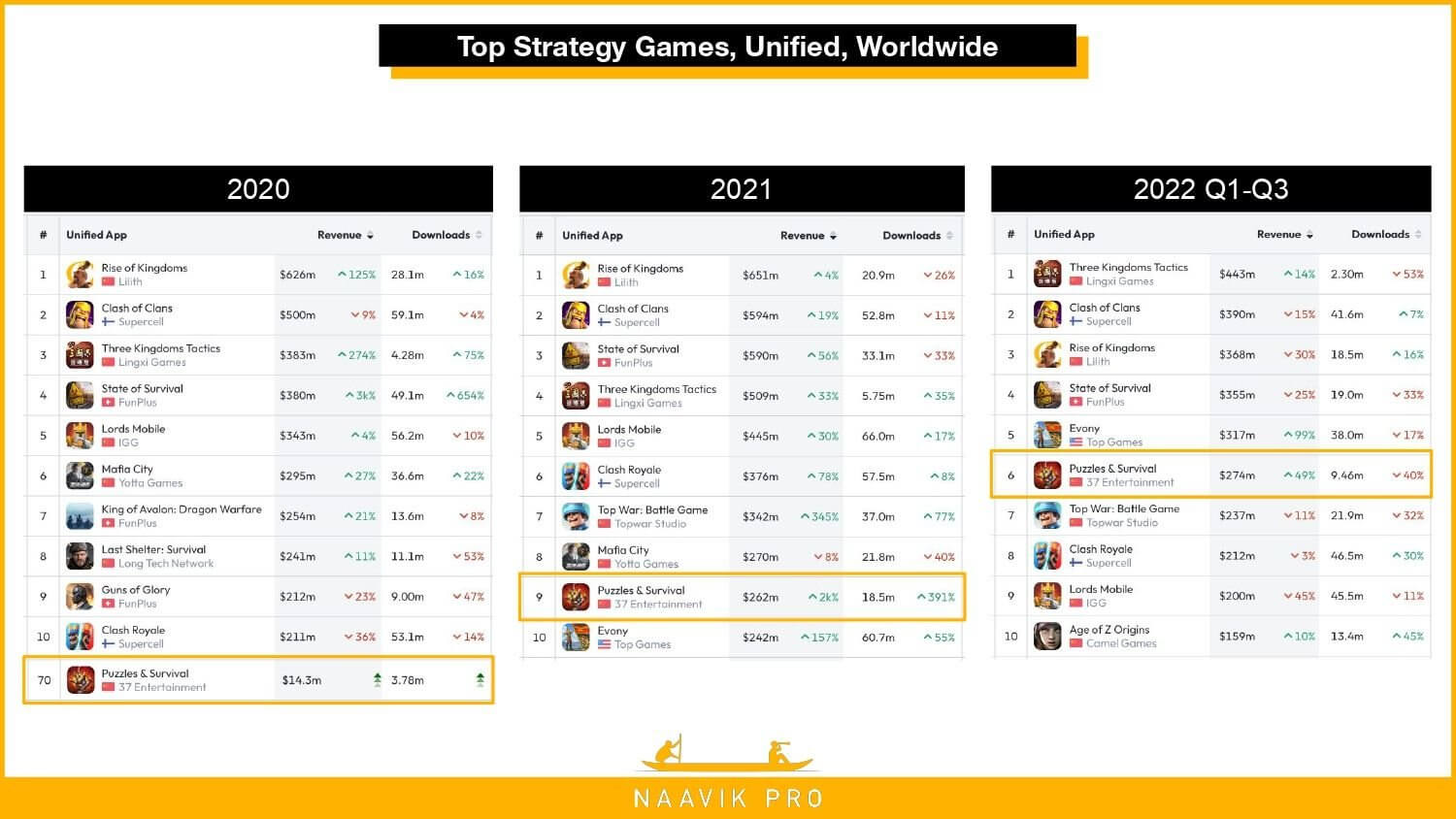
PNS launched in H2 2020, with the dominating top 3 strategy games being Lilith’s Rise of Kingdoms (RoK), Supercell’s Clash of Clans, and Lingxi Game’s Three Kingdoms Tactics, which have remained there, sometimes swapping positions over the last few years. Interestingly, Three Kingdoms is a China-only game that manages to bring in colossal revenue with meager downloads, which is pretty common for top-grossing Chinese games. FunPlus’ State of Survival (SoS), another 4X game set in a zombie apocalypse, has maintained its position in the top 4. In 2021, PNS already broke into the top 10 by revenue strategy games with $262m and 38.5m downloads. As of Q1-Q3 2022, PNS has surpassed the likes of Supercell’s Clash Royale to move up to #6 by top revenue.
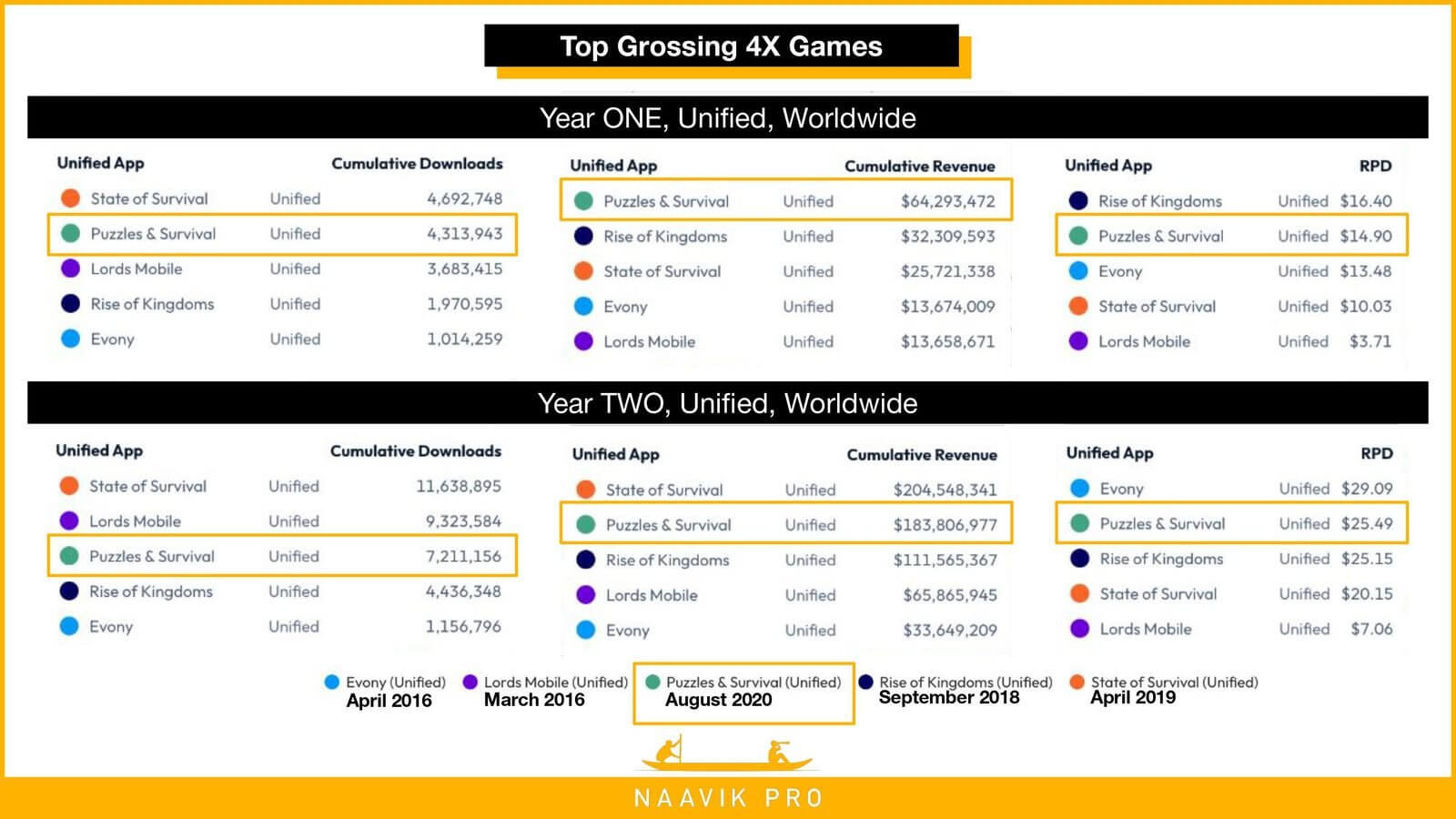
Aligned by launch, PNS was off to a strong start in its first year, leading in cumulative revenue with $64m and second in downloads with 4.3m, closely behind SoS’ 4.6m. PNS reached an RPD of $14.90 in year one since launch, second only to RoK’s RPD of $16.40. The year two performance of PNS shines light on its potential, bringing in $183m in cumulative revenue with an RPD of $25.49, equaling RoK’s RPD. IGG’s Lord’s Mobile has been an outlier with the lowest RPD of $7.06 compared to the other top strategy games. By year two performance comparison, PNS is behind SoS in revenue, and both being 4X games set in a zombie apocalypse hints at PNS taking part of SoS’ market share.
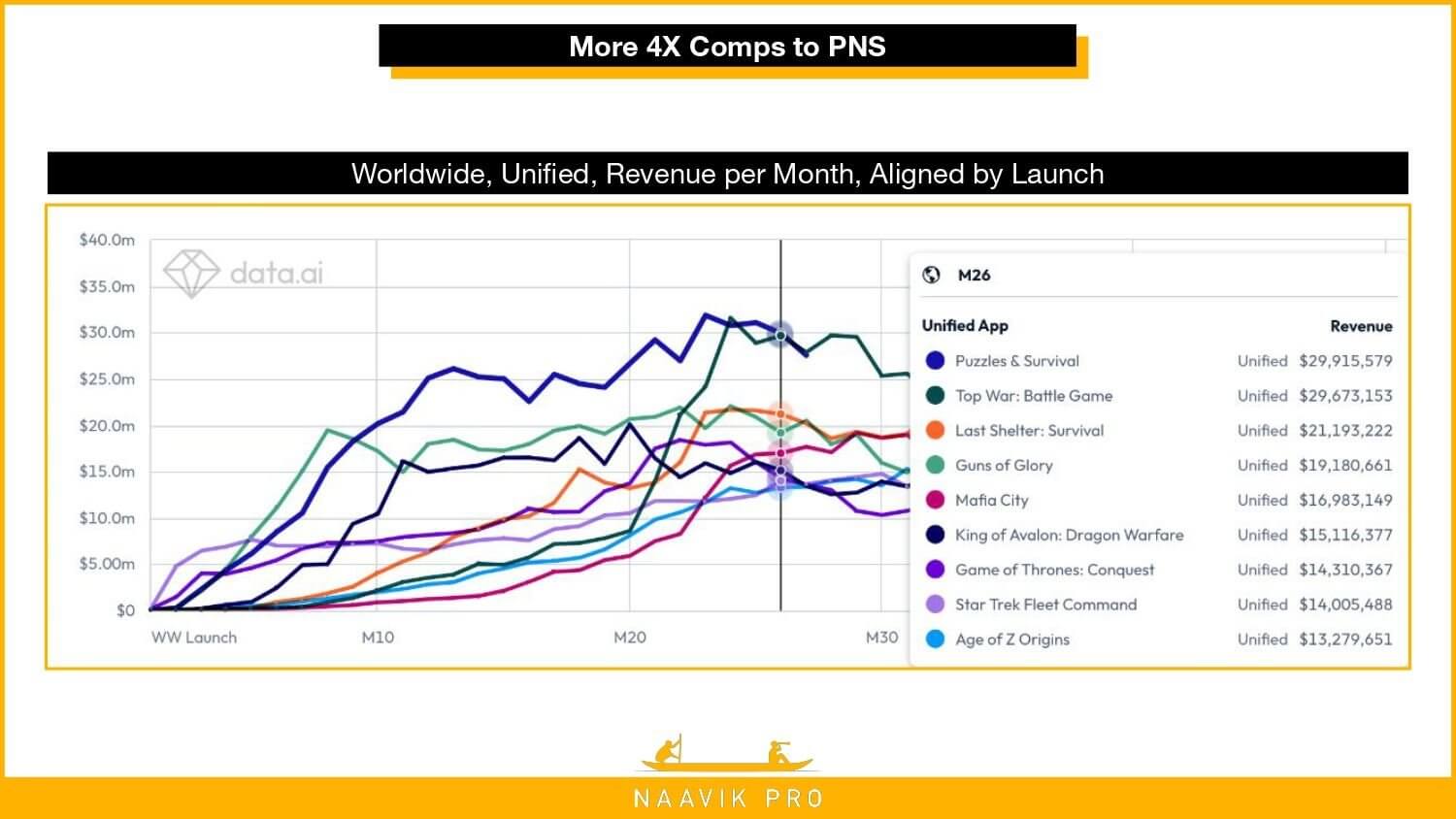
Long Tech Network’s Last Shelter: Survival and Camel Game’s Age of Z Origins are both zombie-themed 4X games made by Chinese studios, making $21m and $13m respectively in M26 since launch. Apart from SoS, FunPlus also has 4X games like Guns of Glory and King of Avalon performing strong with $19m and $15m in M26 since launch. Topwar Studio’s Top War: Battle Game comes closest to PNS in terms of hybrid design strategy as a 4X game with Merge game elements, and its performance follows closely with PNS’ when aligned by launch, with both games making $29m in M26 since launch. While two games don’t make a trend, it is definitely an interesting similarity to keep in mind.
Let’s look into the hybrid game design of PNS driving these strong results.
The Art of War
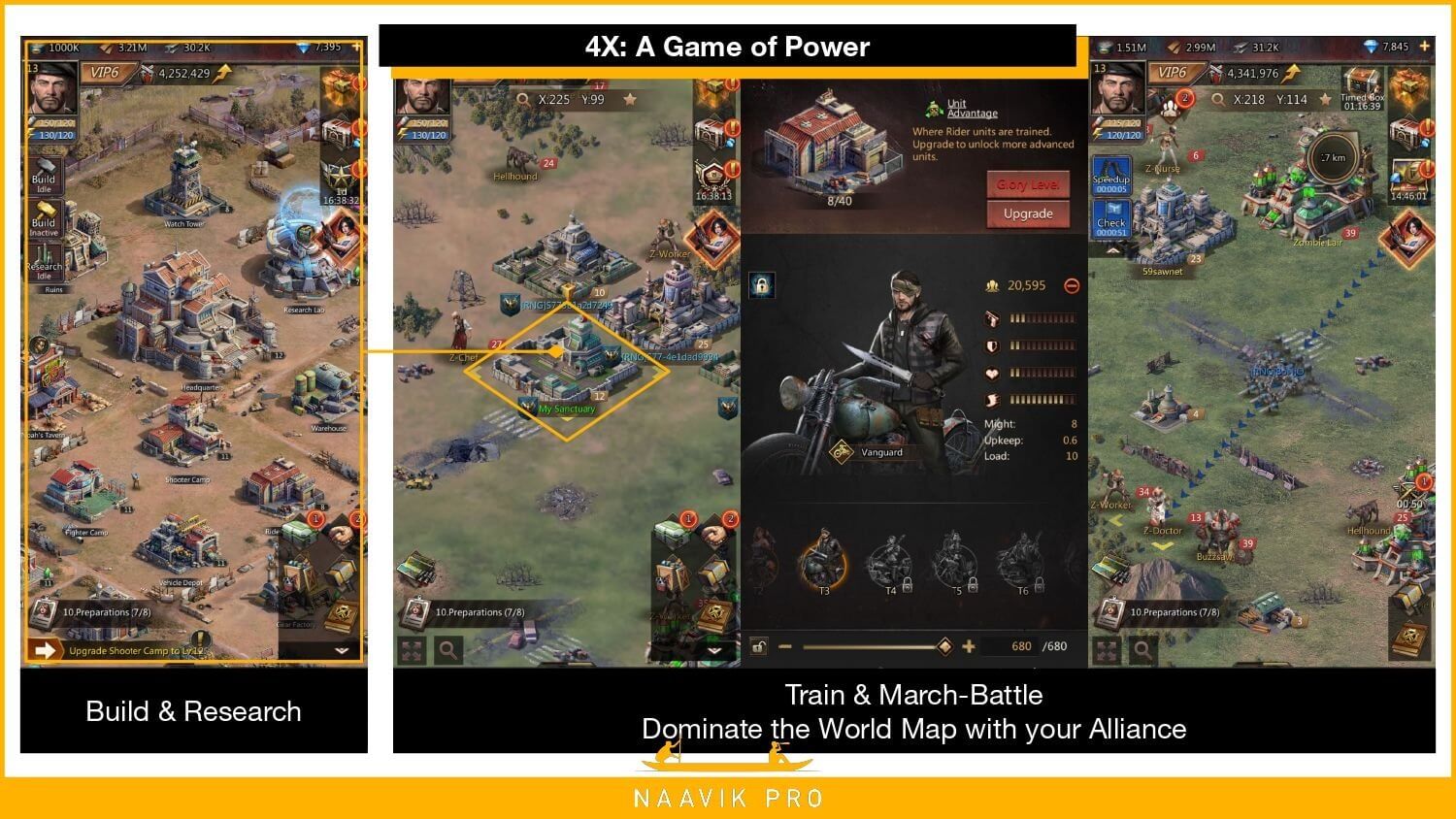
4X games like PNS are about growing in power and dominating other players, aiming to be the most powerful player in the most powerful alliance on the server. Every basic action the player takes, every quest they complete, helps them progress in power, and in PNS, this is represented by a single rating called Might. Building, upgrading, and researching at your base, training units and gathering resources, all lead to an increase in Might. Players start the game in the safety of a ‘beginner’s shield’ on the world map, unharmable by other players till they’ve upgraded their HQ to level 10 (a standard in 4X games). Once this safety bubble is popped, players have acquired enough power, knowledge, and know-hows to enter the unforgiving, ruthless world of PvP that makes 4X games so enticing.
The 4X March-battle’s armies marching system plays out based on distances on the map, with more distant places taking more time for player armies to march. This encourages players to move their sanctuary closer to resources but at the same time maintaining closer distances with alliance allies for reinforcements in case of attack. Players are keen to observe each other’s marching patterns, resources being exploited, and attacks on other sanctuaries, and plan their next course of action on the ever changing dynamic world on their server.
When players train units and March-battle on the map for resources, they can lose Might for losing troops in battle. When player troops engage enemies on the map, mainly PvE in the beginning, an instant battle report is generated depending on the difference in power and types of the two armies. This March-battle system has a lot of depth when it comes to optimizing battle performance and is quite complicated to learn initially before getting the hang of all the underlying systems. The lack of visuals simulating the battle also makes it hard to imagine how these are playing out and adds to the steep learning curve.
This intricate march-battle system is pretty common to all 4X games, including PNS. What PNS’ hybrid design attempts to solve is to smoothly onboard players to its complexity in the mid-to-late game than the early game.
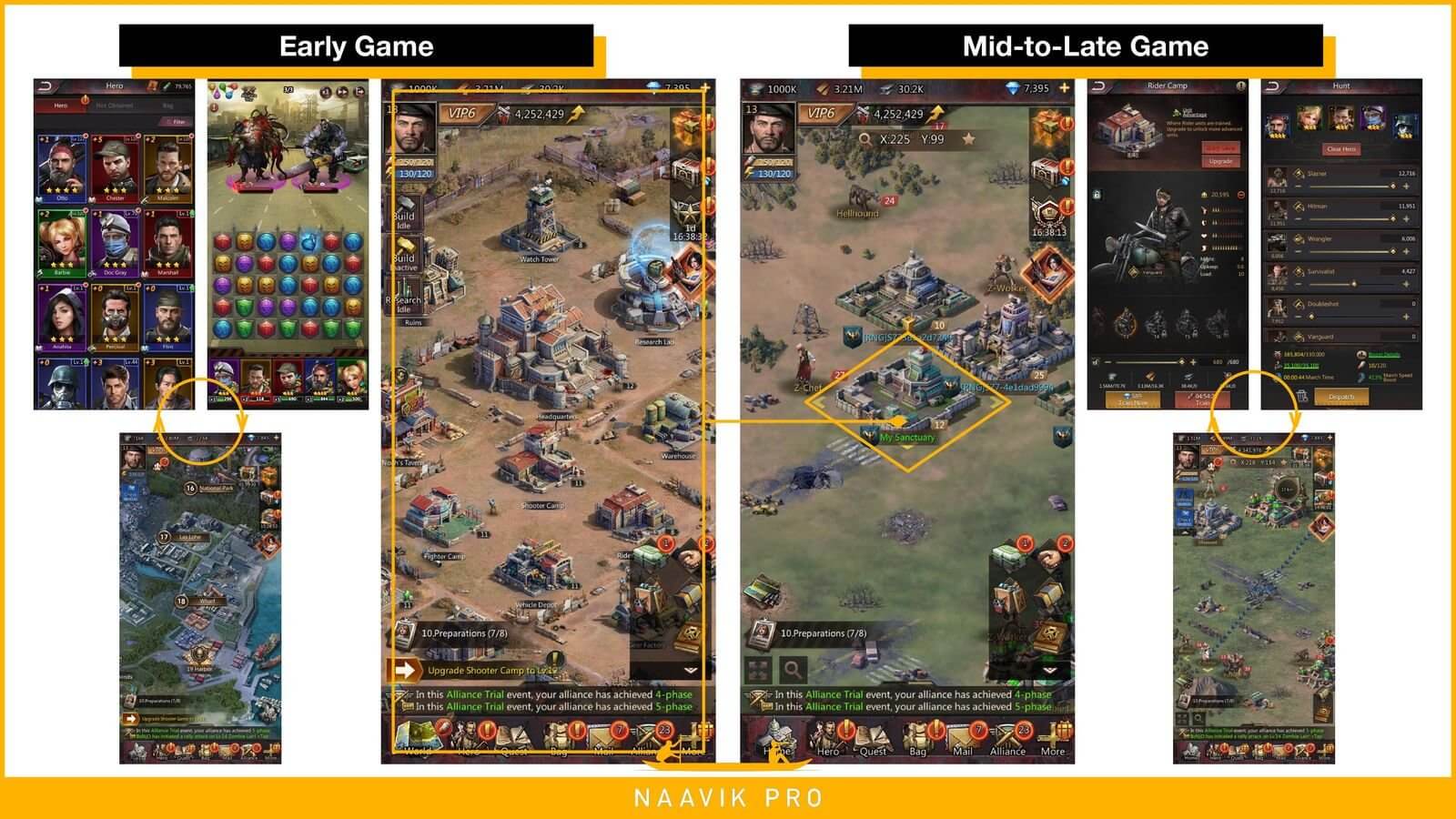
PNS starts off players with the base building and upgrading basics but diverts the experience from there into a more traditional hero collector puzzle RPG. Players are introduced to the gacha machine where they pull heroes from, with their rarity ranging from 1 to 5 stars, make a team, and pursue a PvE campaign of Match 3 battles. The rewards from the campaign fuel the growth of the heroes, upgrades of the base, and research that improves both the Match 3 and 4X aspects. The game also deeply monetizes these puzzle RPG features, primarily through the hero gacha machine where players can pay to acquire stronger heroes.
The hero collection is a shard-based system seen in games like Scopely's Marvel Strike Force where players need to collect all shards of a hero to unlock them. PNS is very generous with shard drops, and the gacha machine gives out frequent free pulls. An exponentially increasing amount of shards are required to rank up heroes, though every shard drop feels rewarding as a small amount of progress. The best part of PNS’ hero collection is that every hero, irrespective of their star rating, is rewarding to unlock and upgrade, as they have passive abilities that are in effect for just owning them, like a bonus to resource production, discounts to build and research costs, and stat bonuses for the player’s armies.
A common criticism of this type of shard gacha system is that, although it’s easier to initially unlock the best heroes, the progress to fully upgrade them is hard, requiring 1000+ duplicates. This also makes the monetization of the hero collection feature weaker compared to solid token gacha systems, like in Empires & Puzzles where the drop rates of the rarest heroes are less than 1%, requiring hundreds of pulls to initially unlock a hero.
The Match 3 battles too are standard fare seen in games like Empires & Puzzles, where players make matches on the puzzle game board to attack enemies in lanes on top of the puzzle board. The damage done depends on the power of the heroes corresponding to the color being matched as well as strengths and weaknesses of the enemy color - Red beats Green, Green beats Blue, Blue beats Red, Darkness and Light beat each other, where ‘beat’ means doing bonus damage. Heroes fill up a rage bar as their colors are matched, and once full, their unique powerful skill can be activated, usually doing damage to all enemies, healing allies, or providing status changes like poison and regeneration.
The power growth and strategy of the early game puzzle Match 3 RPG acts as a steady introduction to the more strategic gameplay of the late game. Players are smoothly transitioned from the PvE, single-player features of the puzzle match-3 battles to the PvP, multiplayer features of the 4X march-battles, naturally encountering other players on the map and nudging them into joining alliances for survival in the unforgiving zombie apocalypse. This helps less hardcore strategy players get enough experience in the game before transitioning to the more hardcore strategic 4X war elements.
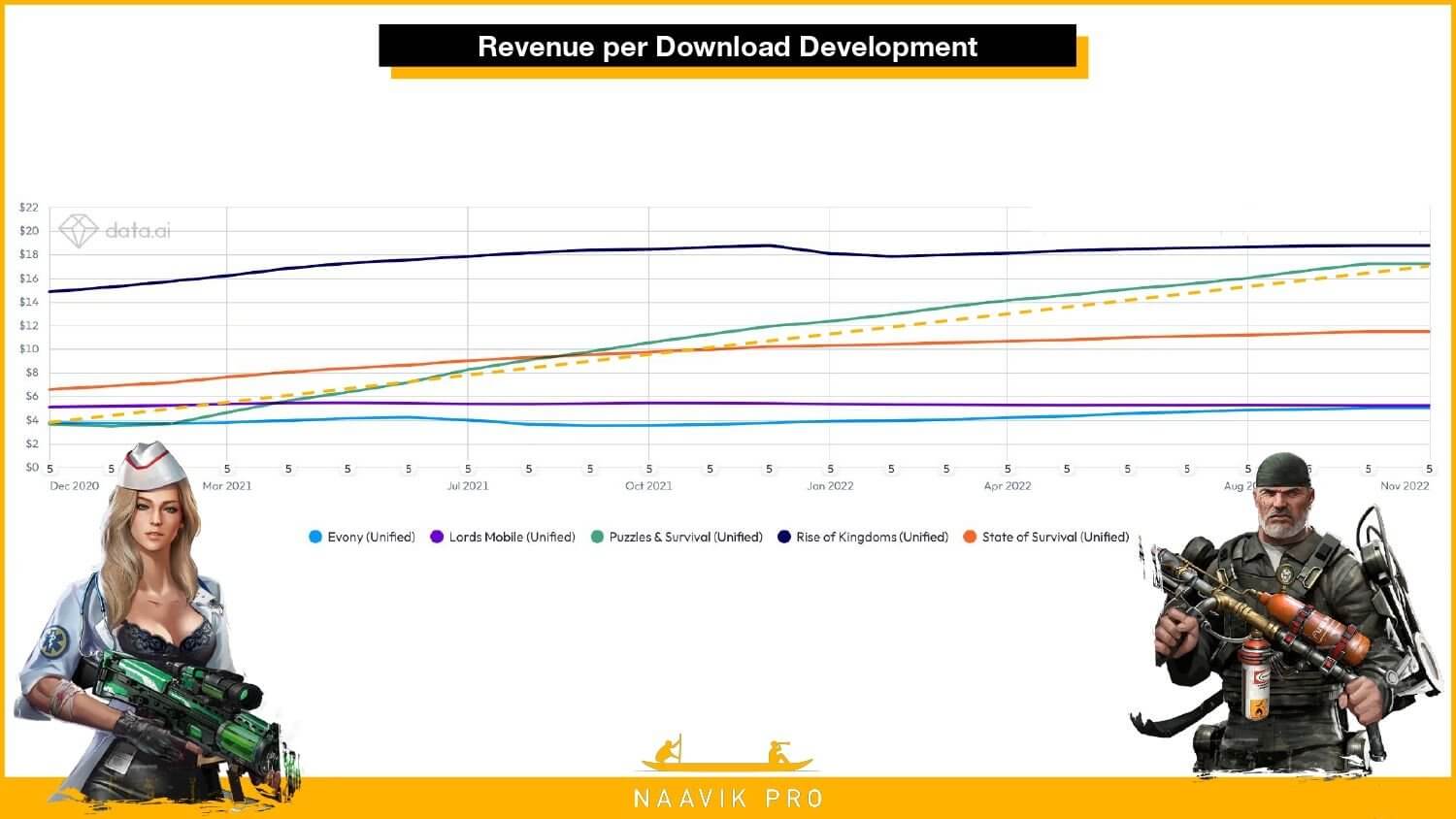
The impact of this can be seen in PNS’ Revenue per Download development as PNS starts off much lower than its top-grossing competitors but seems to beat many of them longer-term. PNS is trading higher early revenue of the 4X genre efficiently for higher accessibility brought by the Match 3 RPG genre. This is heavily tied to PNS’ UA strategy relying on broadening its top of the funnel as much as possible by showcasing the Match-3 gameplay first and then attempting to retain players long-term until the heavy monetization kicks in.
Broadening the Top of the Funnel
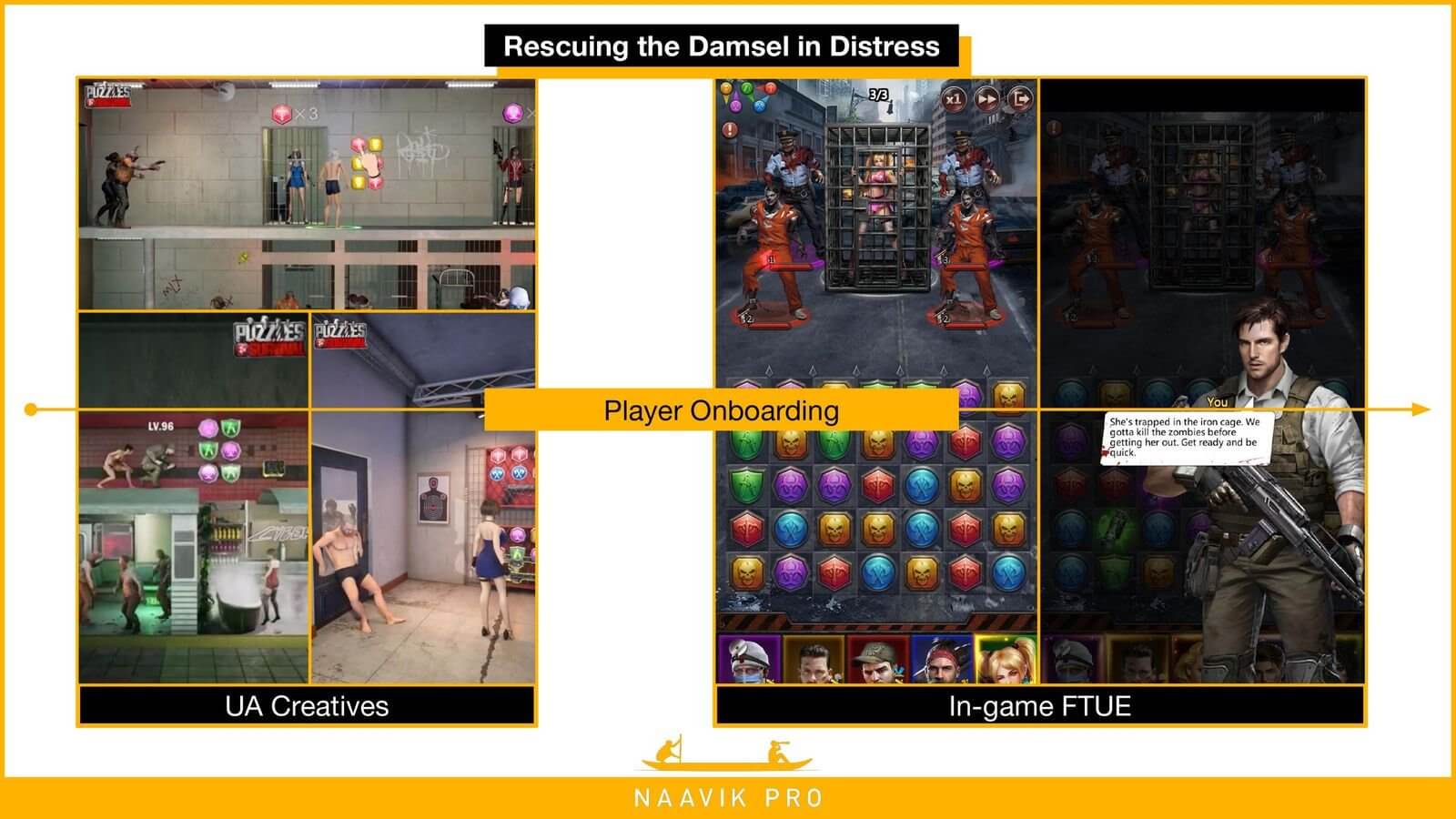
The match-3 puzzle element is used across PNS’ advertising to appeal to broader mid-core strategy/RPG players, usually involving simple puzzles to open doors or gates as characters try to escape a pursuing zombie horde. The matchables (elements of the match-3 board), the characters, and the setting are distinctly PNS, with the fantasy usually involving ‘rescuing the girlfriend’ — a common trope used across most advertising on mobile. When players get the game through the ADs, the in-game tutorial takes players through a similar arc of rescuing survivors, primarily a damsel in distress who is captured by the zombies.
This synergy between the advertising and in-game elements helps funnel players into a cohesive experience that keeps them engaged and acts as a feedback loop for the advertising to be effective in getting players. This approach shows a strong synergy between the game and UA teams, effectively building and sharing ideas that makes the advertising as well as the game product more effective.
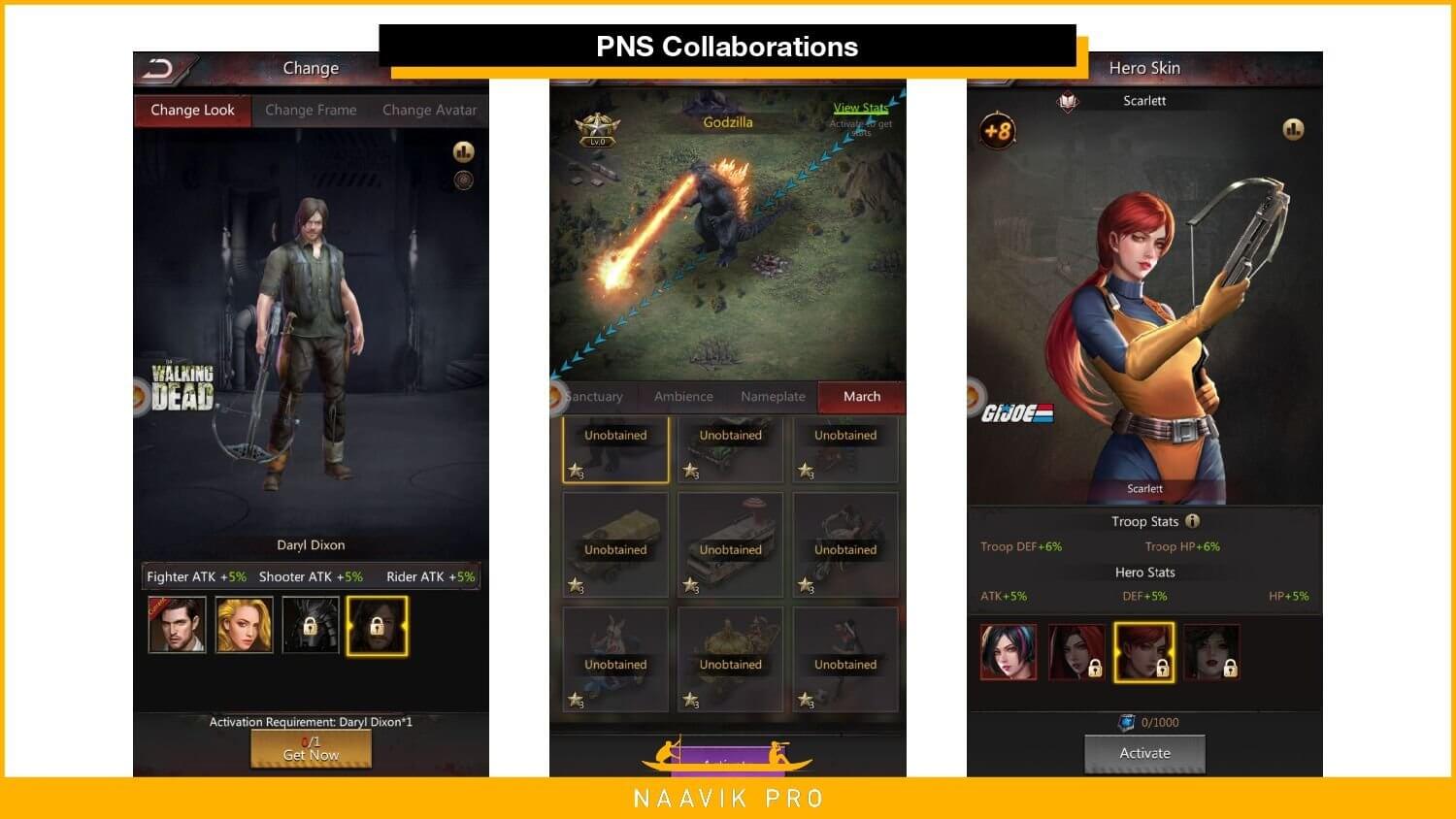
PNS has also done several collaborations with brands like G.I. Joe (link), Godzilla, and The Walking Dead (link), which mostly come in the form of skins for the game characters, the player’s avatar, sanctuary headquarters, and troops marching on the map (yes, that is Godzilla in the screenshot above when applied as a skin for marching troops!). The brand integration is high quality and usually supported by ADs taking full advantage of the brands.
In-game, players get to battle against or alongside the collaboration heroes as they chase collecting various tokens in featured events to unlock them. The Walking Dead was heavily used in promoting PNS’ 2nd anniversary celebrations and has been a brand used by zombie/horror games in the past to great effect, like FunPlus’ State of Survival (link). In celebration of the Football World Cup 2022, PNS is adding a match 3 PvP event and an endless runner mini-game alongside skins like the soccer stadium for the headquarters (link).
These three aspects of PNS’ creative strategy — Match 3, fake ADs, and IP ADs — help cast a large net to acquire the largest possible audience. In the post-IDFA world, F2P game developers (especially those of strategy genres) are highly incentivized to broaden their top of the funnel as much as possible. Casting a wide net brings all kinds of possible players in (since companies cannot really target players anymore), and then it’s up to the game to convince the maximum number of those players to retain and eventually monetize. What we’re seeing happening with PNS or Top War or X-Hero is a new constraint on the F2P business model — the lack of targeted UA — defining game product design.
Healthy Live Operations
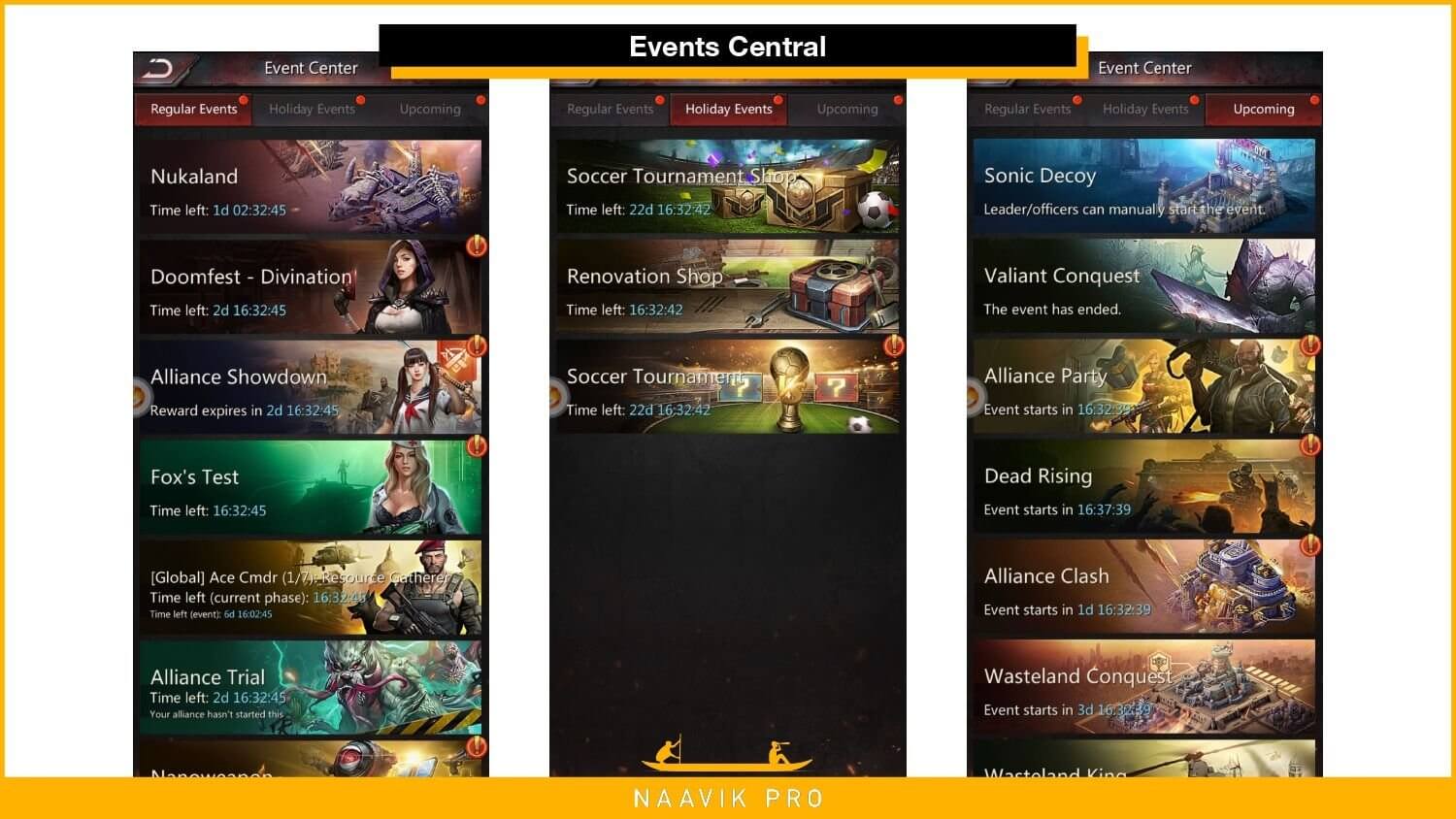
PNS’ event schedule is a clockwork framework of recurring regular events that repeat every two weeks and can be broken down into 4 types:
- Point-gathering events with milestone rewards that are earned by repeating a certain activity in the game like performing upgrades or battling on the map. These usually require heavy engagement during the event period to unlock all the tiered rewards, and further there are ranked rewards to be earned by competing with other players on the designated activity.
- Casino events like slot machines and lucky pulls that have variable, randomized rewards that can be obtained by earning tokens by completing daily quests.
- Alliance events that require participation as a group towards earning points and rewards together, either in a PvE context of taking down mutant zombies or in a PvP context of battling other alliances for control.
- Gimmick events like a multiple choice test or mini-games that act as short, fun distractions from all the other content in the game, usually a testing ground for upcoming game updates.
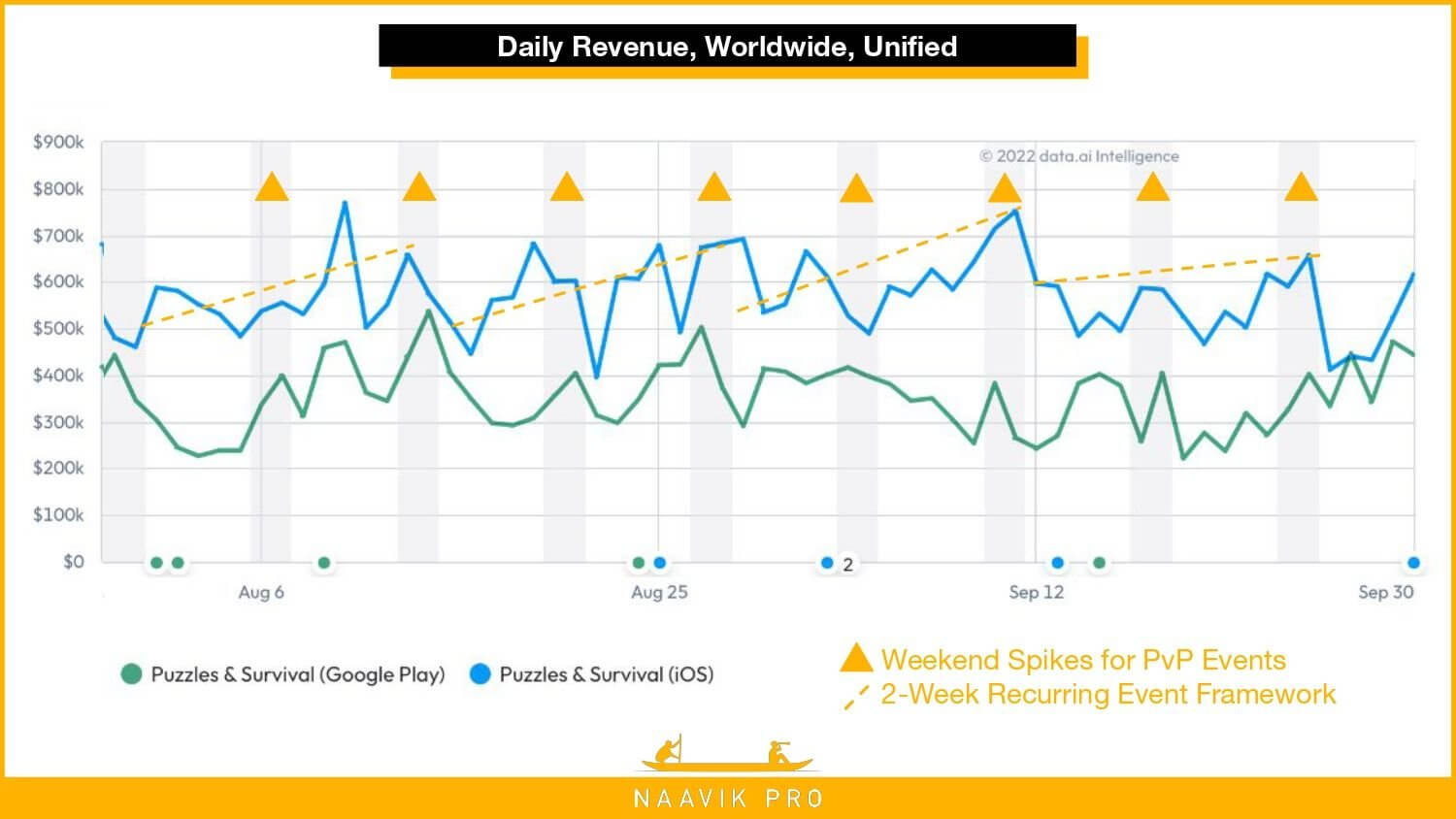
The recurring nature of these events makes it easy for players to plan out their sessions in two-week periods and maximize the potential of getting parallel rewards when performing certain game actions like upgrading and researching. With a large part of the events being alliance-only, players are effectively nudged to find a group and actively play as a group as the most effective way to progress.
For the Horde!
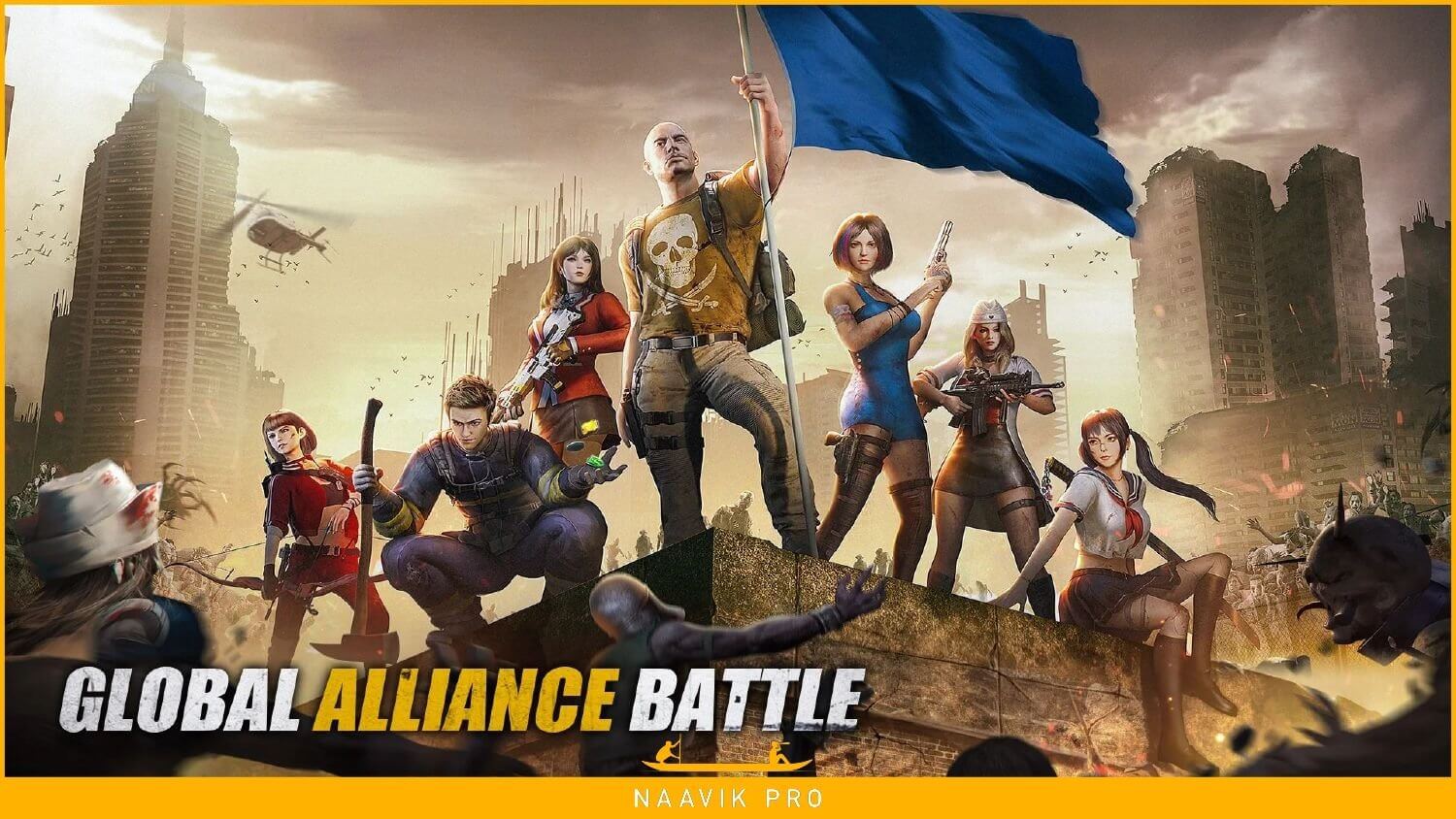
PNS’ alliance features are streamlined to level up every aspect of the game, from simple timer-reducing help from allies and alliance gifts with every purchase, to joining war rallies on the map to target enemies as a group for increased rewards. Every member of the alliance also gets all the benefits of the Alliance Research Tree — an additional skill tree all members can donate towards and unlock permanent buffs to resource gathering, heroes, and troops.
For being an active member of the alliance and responding to requests, players earn alliance coins that can be redeemed for resources in the alliance shop. There are unique alliance buildings that can be used by allies for jobs like protecting resources in the alliance warehouses, using the alliance hospital to heal troops, and the alliance gathering point which can be used to safely gather resources at an increased rate. An alliance fort forms the center of alliance territory, and players who move their sanctuaries physically on the map into the alliance territory gain additional buffs as well as the advantage of marching shorter distances when responding to a call for troops.
Almost all these features are staples to alliance features in the 4X genre and lead to the formation of alliance cities on the map: super social hubs of players working together to survive, grow, and dominate. Achieving feature parity of events and alliance features with market benchmarks is the easy part, but operating them effectively to maximize player LTV is an exercise in constant optimizations. PNS manages to hit the mark with its alliance features, making it easy and highly effective to play socially, but lacks the same precision in its social events tuning, where players are frequently matched to fight others who are way above their power levels.
Gotta Collect 'Em All
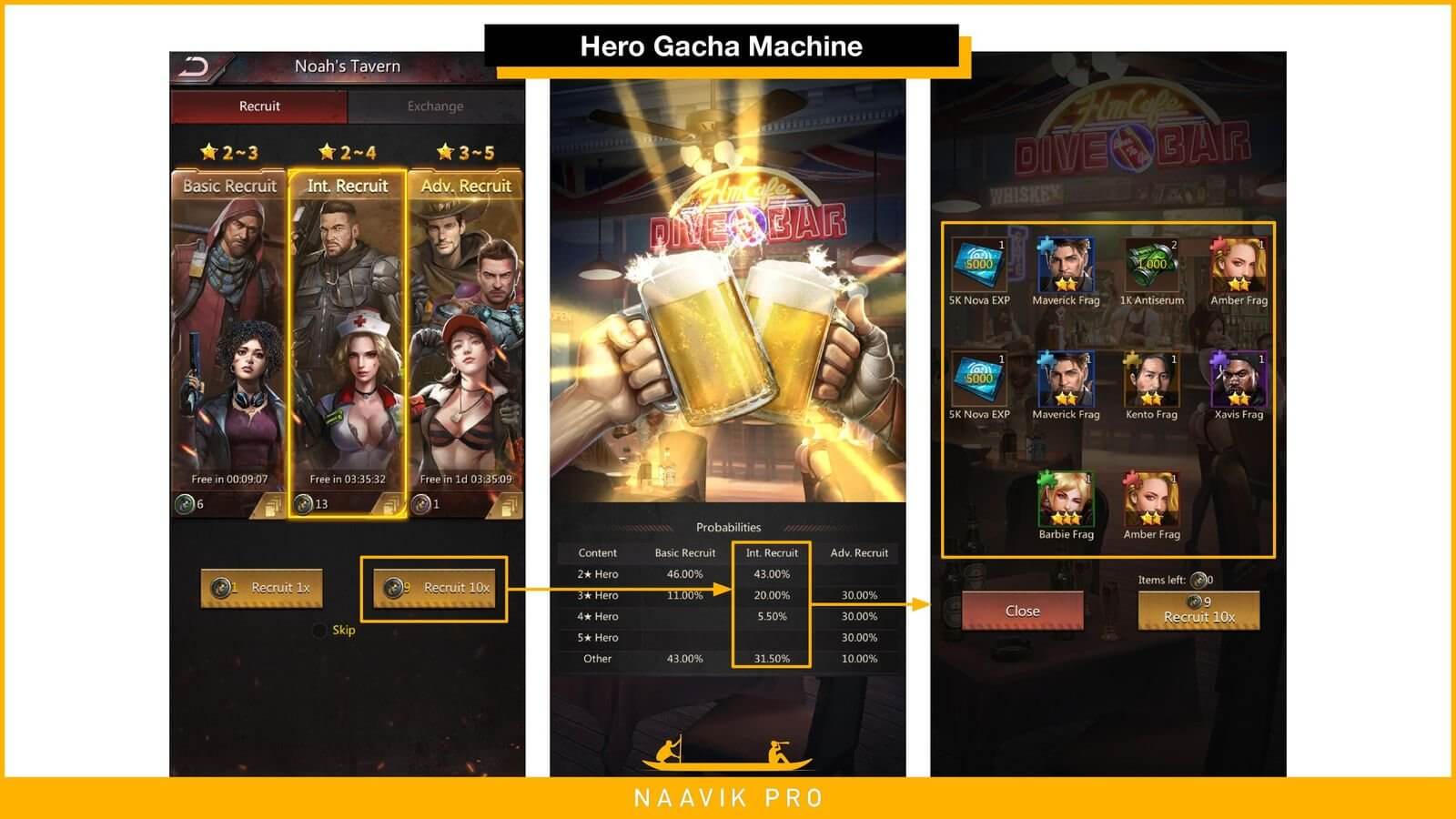
Unlocking new heroes in PNS requires players to collect 10 hero fragments (shards), which can then be combined to unlock the hero. Duplicate shards are used to enhance heroes to a max of +8, with each level requiring more and more shards, starting with 10 shards for +1, 20 shards for +2, and so on till requiring 500 shards for +8. A total of 1050 hero shards are required to unlock a hero and max out their enhancement. These shards are pulled from the three different gacha machines at Noah’s Tavern: Basic for 2-3-star heroes, Intermediate for 2-4-star heroes, and Advanced for 3-5-star heroes. 5-star hero shards are only available in the advanced gacha machine for a drop rate of a very helpful 30%, and 10 pulls are sold as a bundle with upgrade resources for $20.
The game is generous with free pulls, habituating players to return to Noah’s Tavern every 4 hours for a free Basic pull, every 24 hours for a free Intermediate pull, and every 48 hours for a free Advanced pull. Hero shards are also obtained through the Campaign, Events, as well as drops from battles on the world map, though Noah’s Tavern remains the primary source. The shards trickle over time, and frequent drops across the game’s various systems feel rewarding as small steps of progress. The game does a good job of incorporating the resources for hero collection in its monetization.
As discussed earlier, onboarding players to this Match 3 RPG monetization starts PNS off on a lower early revenue per download compared to its 4X competitors. But widening the top of the funnel by retaining and transitioning more players into the 4X monetization is key to its store and monetization design discussed below.
Puzzles & Purchases
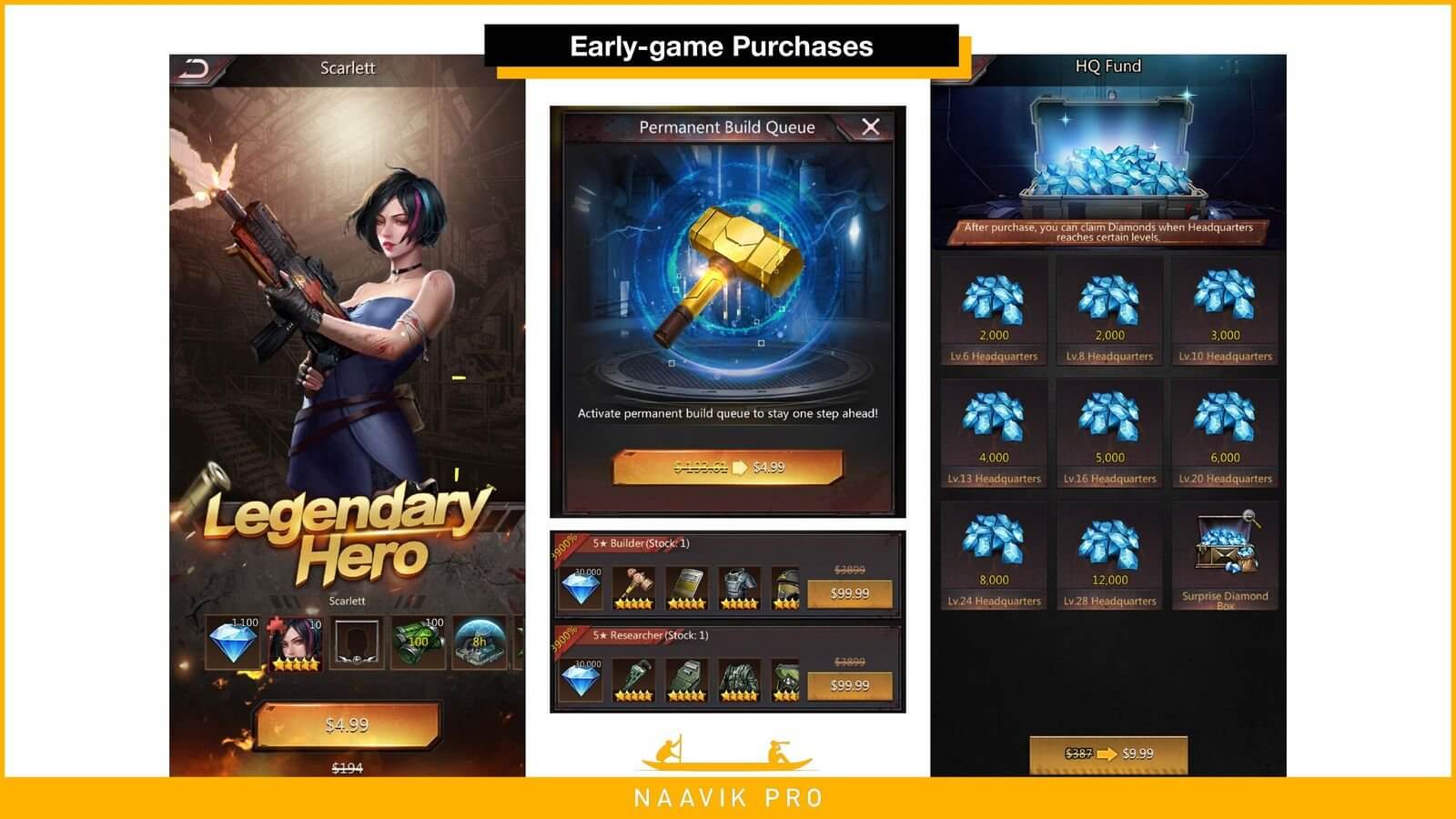
Scarlett, a 5-star hero used majorly across the game’s advertising and branding, is the only paid-only hero in the game. This is showcased to players as the first offer in the game, starting at $4.99 to get 10 shards to unlock the hero as well as silver profile frame, an 8-hour shield to their sanctuary, and some upgrade resources. Once this offer is bought, it's replaced by the next Scarlett enhancement offer for shards to enhance her to the next level. Getting a head start with a 5-star hero makes it a very attractive offer for players to purchase early on. Scarlett also comes with passive benefits like free time skips for 80 mins and increasing max troop size.
Similarly, the game offers an attractive additional permanent build queue purchase for $4.99, allowing players to have 2 buildings being built or upgraded, essentially speeding up their progress by 2x. The game promotes purchasing an HQ fund — a $9.99 purchase that rewards players for progress in building and upgrading their base headquarters every 2-4 levels — which goes well with additional build queues and players looking for fast early progress. For the heavy spenders, the game offers two $99.99 early purchases — one for a 5-star Builder and one for a 5-star Research that permanently discounts all build resource requirements by -20% and research resource requirements by -12%.
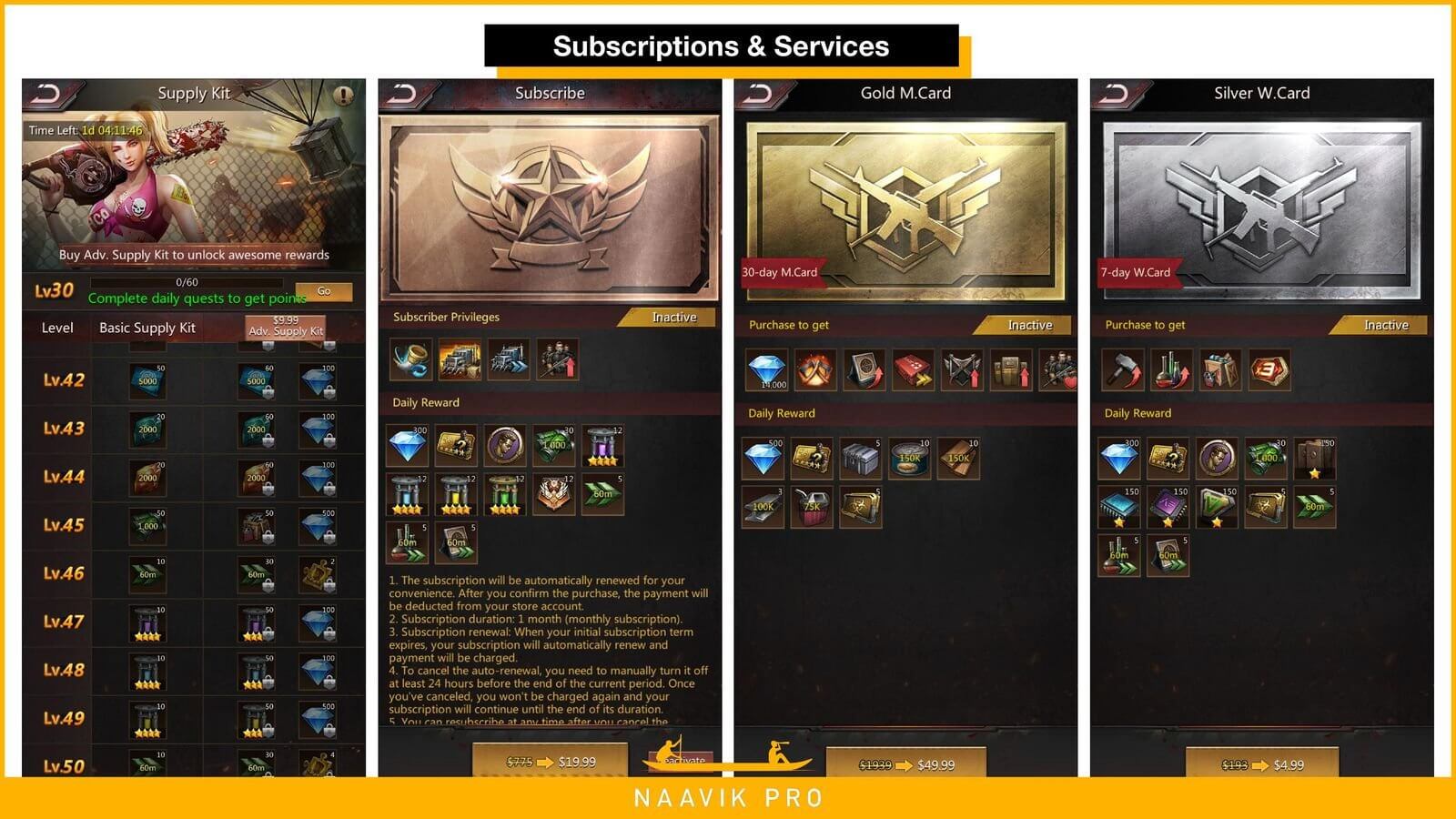
PNS’ monthly battle pass progress is tied to completing daily quests and has a free basic tier of rewards and two paid tiers of rewards for the premium advanced pass of $9.99. The game has a $19.99 subscription that boosts energy regeneration for march-battles, increasing resource-gathering speeds and max troop size, as well as rewarding the player with daily bundles of resources. The subscription lasts 1 month and auto-renews after the first purchase. If the game is starting to feel trending towards more pay-to-win aspects with the paid benefits to troop sizes, it outright sells a monthly Gold Card for $49.99 that directly boosts all troop damage, defense, health, as well as training and healing times. A weekly Silver Card for $4.99 is targeted more towards boosting upgrade and research times.
As a game predominantly about chasing power, PNS does not shy away from monetizing direct power purchases and giving players benefits against battling other players. These paid power purchases might seem unfair in other PvP games with ranked leaderboards but are staples in 4X titles, which, from a player motivation standpoint, are about getting to be the most powerful whatever it takes and the fantasy of dominating other players with whatever means necessary.
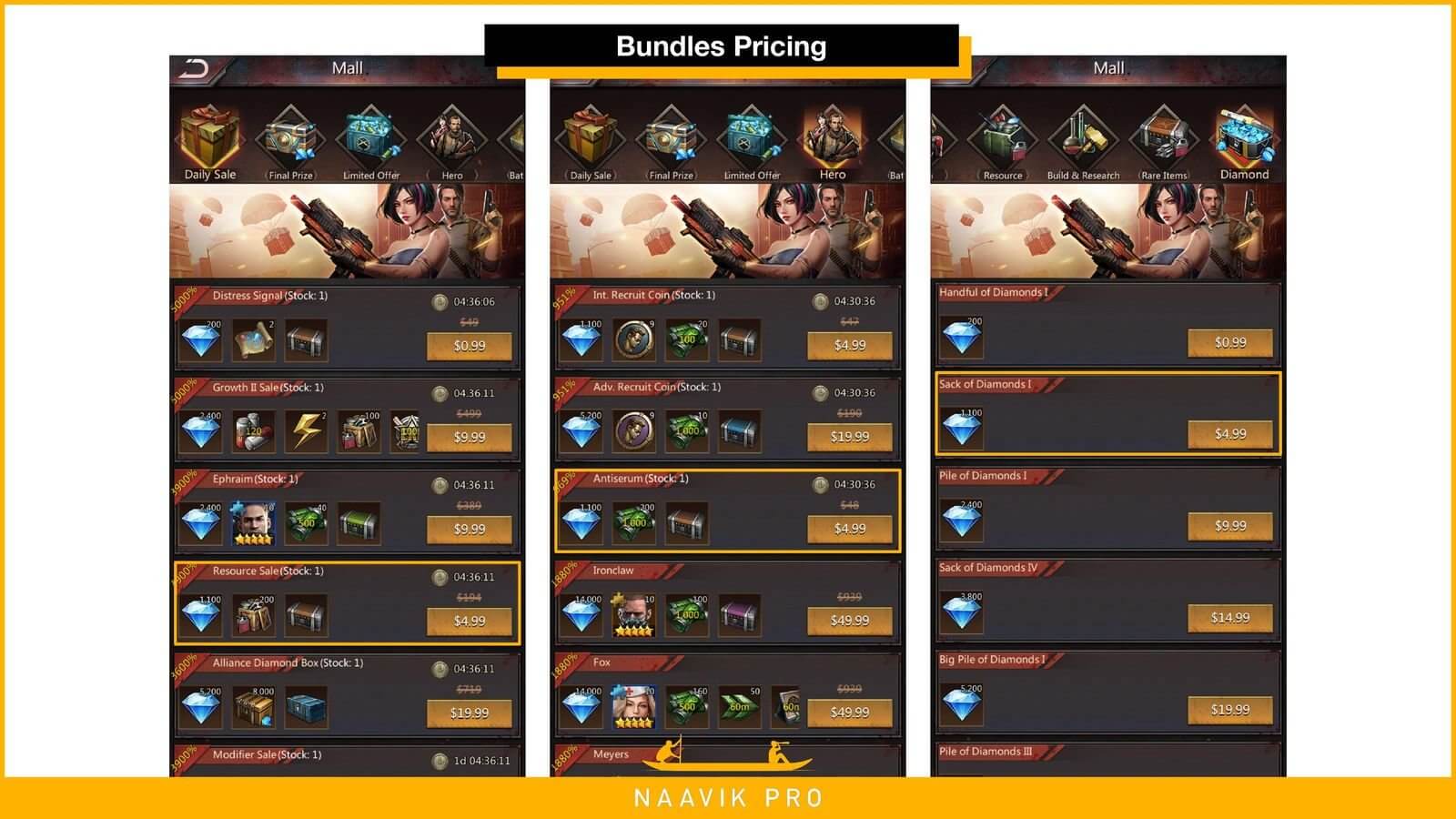
The game does a curious implementation of pricing its premium currency — the diamonds — where direct purchases of diamonds are priced at the same price points as bundles of those diamonds with resources. For example, $4.99 buys 1,100 diamonds, but players can instead opt for purchasing a Resource Sale for $4.99 that contains the 1,100 diamonds as well as various resources for building and researching. Similarly, players can purchase a bundle of Antiserum (a resource used to upgrade heroes) for $4.99 that contains the 1,100 diamonds alongside the antiserum and alliance gift box. Also, every bundle purchase comes with a gift box for all alliance members.
This pricing strategy ensures players have all the necessary options to choose from when it comes to resources and are nudged towards bundles but makes the cost of calculating effective dollar-to-resource prices very unintuitive. The in-game store caters to different resource types, starting with the daily sale that features resources primarily for ongoing events, followed by limited offers that contain daily, weekly, and monthly limited bundles, followed by bundles for resources for heroes, building, and research, and the final tab that contains the diamonds, primarily for anchoring prices and driving players to the bundles that come before.

The way all of these bundles and purchases come together while making a transaction is: if the bundle sells the same amount of diamonds and the standalone diamond purchase, the transaction on the App Store is made for the diamond purchase. For example, in the above image, the Scarlet Hero Bundle comes with 1,100 diamonds which correspond to the ‘Sack of Diamonds I’. When making the Scarlet Hero Bundle purchase, on the App Store the player is prompted with the ‘Sack of Diamonds I’ purchase. Similarly, when buying the monthly season pass, which comes with 2,400 Diamonds corresponding to the ‘Pile of Diamonds I’ purchase, on the App Store, the player is prompted with the ‘Pile of Diamonds I’ purchase.
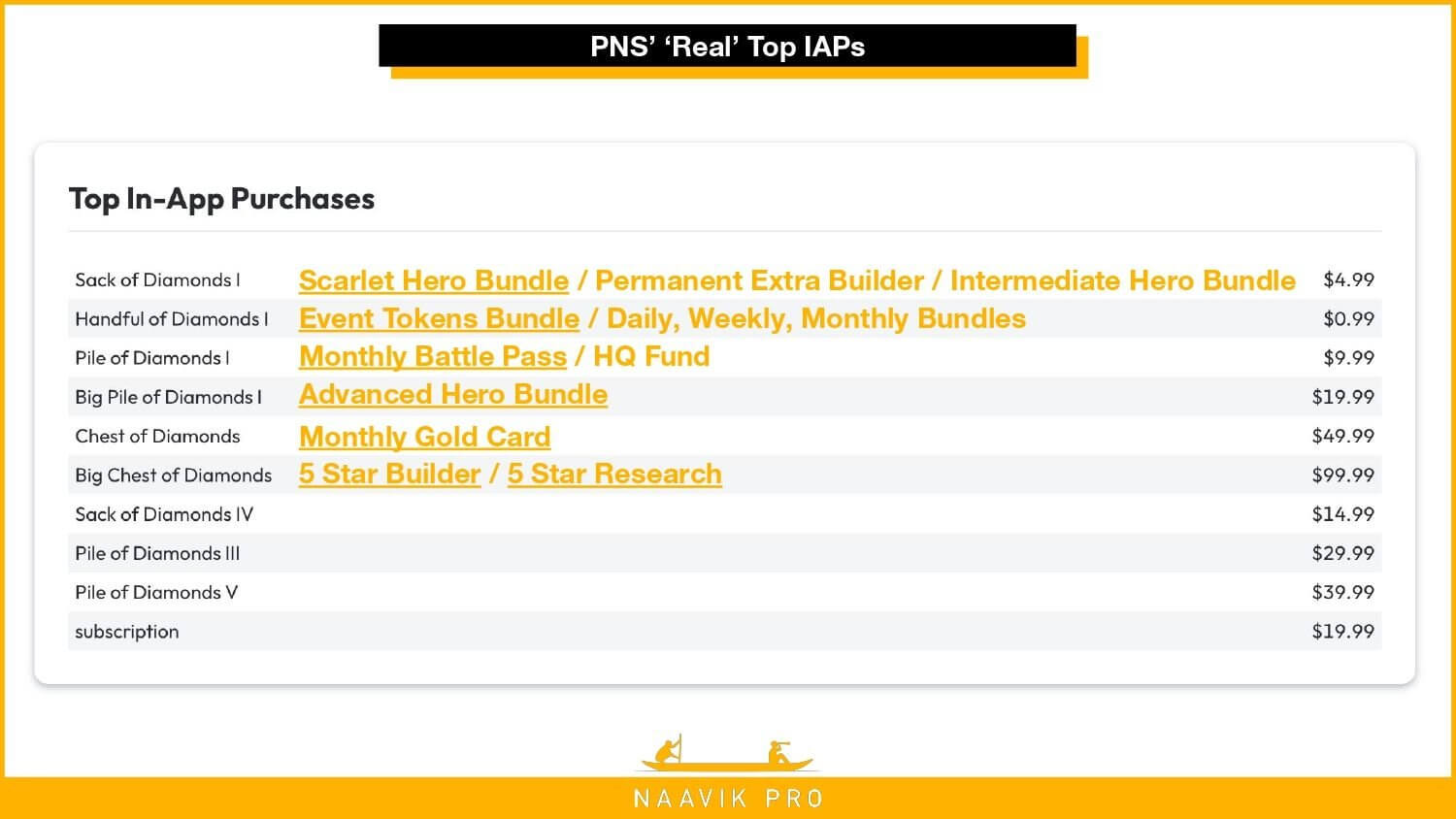
This makes the ‘real’ list of top IAPs, as shown in the above image, with the Scarlet Hero Bundle and Permanent Extra Builder bundle leading the IAPs, the $0.99 priced Event Tokens which change daily with ongoing events coming 2nd, and the Monthly Battle Pass coming in 3rd. The battle pass coming in at third was definitely great to see, as we had initially assumed the IAP named “subscription” in the image above was the battle pass, and it was shocking to see it at the bottom of the list.
Survival of the Fittest
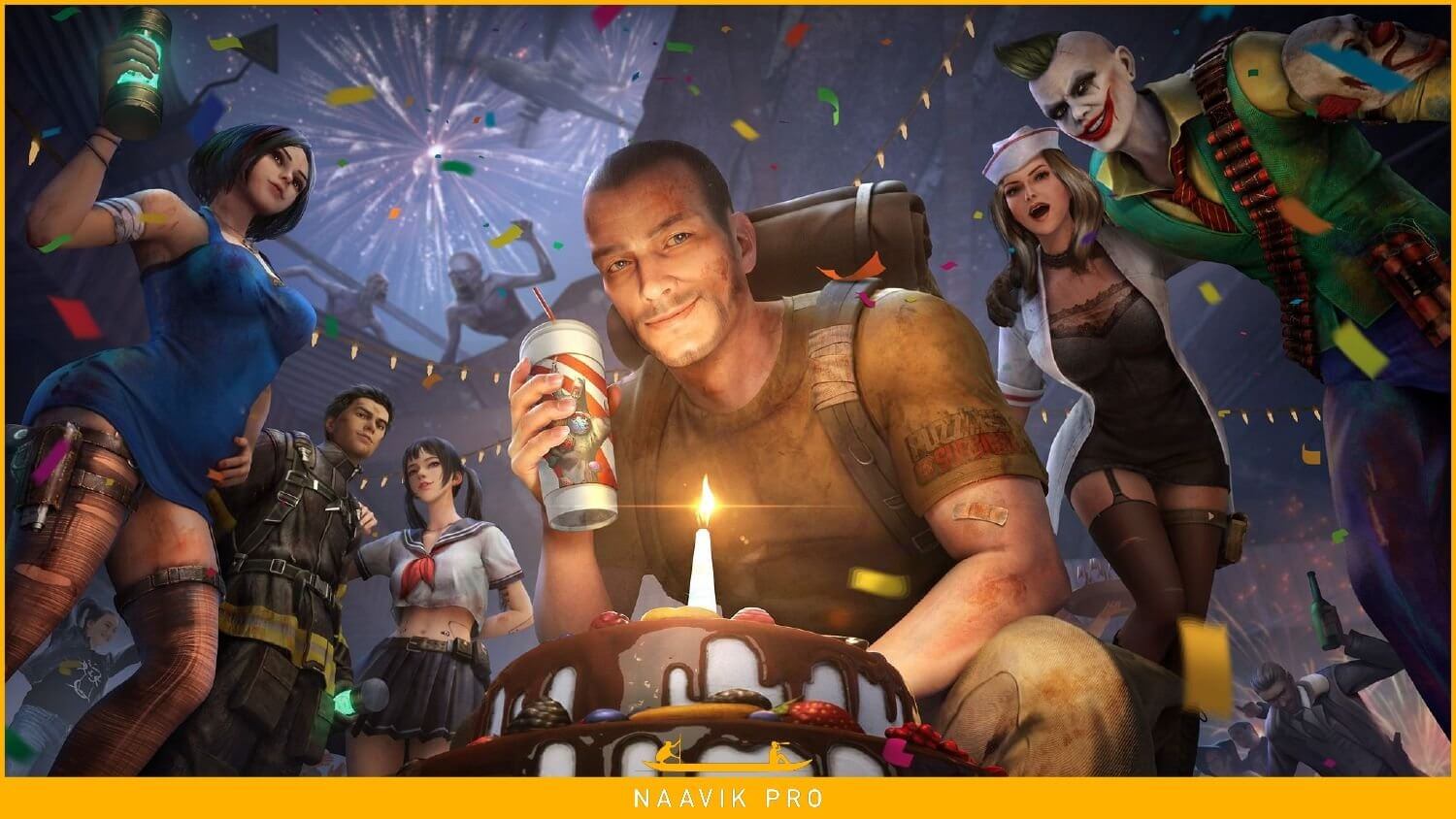
37Games had a feature-complete 4X meets Puzzle Match 3 RPG hybrid game in the form of the fantasy game Puzzles & Conquest. It took a close understanding of its product, market, and marketing environment to iterate on the strengths of that hybrid game to create PNS, set in the aftermath of the zombie apocalypse - a near perfect metaphor for players to band together in an unforgiving race for power in the brutal, deceiving world of human ingenuity.
As a hero collector RPG, PNS succeeds in creating a strong, diverse group of unique heroes, and more importantly, it accomplishes in forming powerful collection drivers for players to collect and max out all the heroes. With the addition of offense and defense squads in PvP combat, as well as sharing heroes with allies in certain events, PNS grows its list of features closely with benchmarking the best hero collector RPGs on the market.
As a 4X hybrid game, PNS manages to appeal to broader strategy players, which helps the game pursue profitable UA in the world of IDFA depreciation that began in April 2021, 8 months after the global release of PNS. Most newcomers in the genre similarly brought more hybrid gameplay into the mix to broaden their demographics, such as with Top War’s merge mechanics and State of Survival’s hero collector RPG mechanics which PNS takes ample inspiration from.
What the market can learn from PNS’ success story can be summed up by three things:
- How to find a fitting theme for a certain gameplay design
- One approach to a post-IDFA UA strategy for 4X (or more broadly Strategy) mobile F2P games
- How to scale LTV over the long-term once the game has broadened the top of the funnel
Most importantly, adding a Match 3 aspect to a 4X game was initially a strategy to differentiate from the market. But the way 37Games put its hybrid design to good use in the current environment to drive its UA strategy really helped PNS combat IDFA depreciation woes. This is a great learning showcasing that the best game developers are the ones who find ways to adapt their scaling strategy based on how the environment is changing.
With the successful release and operation of PNS, 37Games has managed to create a massive hit in the overseas market. With a full production schedule of more than 50 upcoming games in the pipeline, 37Games is aiming to be a top-tier company in mobile F2P in the near future.
A big thank you to Harshal Karvande for writing this deconstruction. If Naavik can be of help as you build out your games and gaming businesses, please don’t hesitate to reach out.


